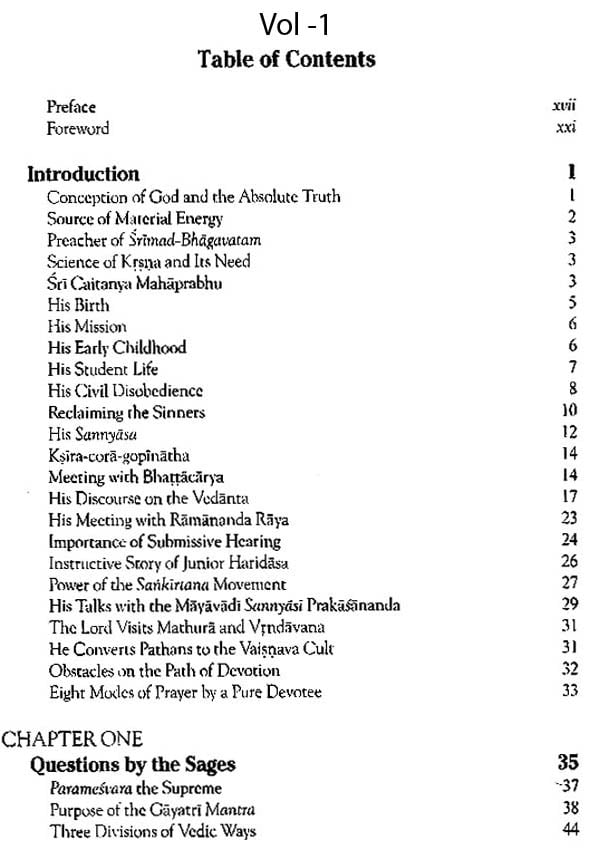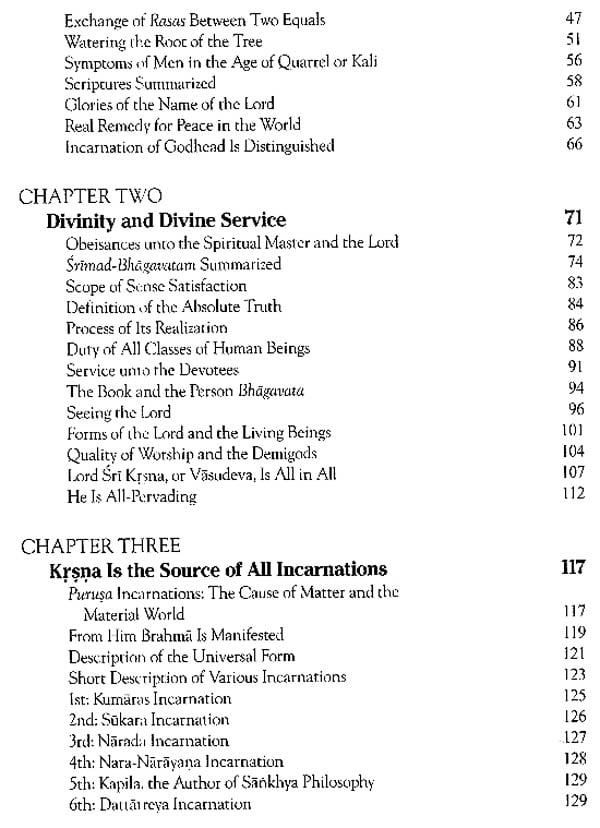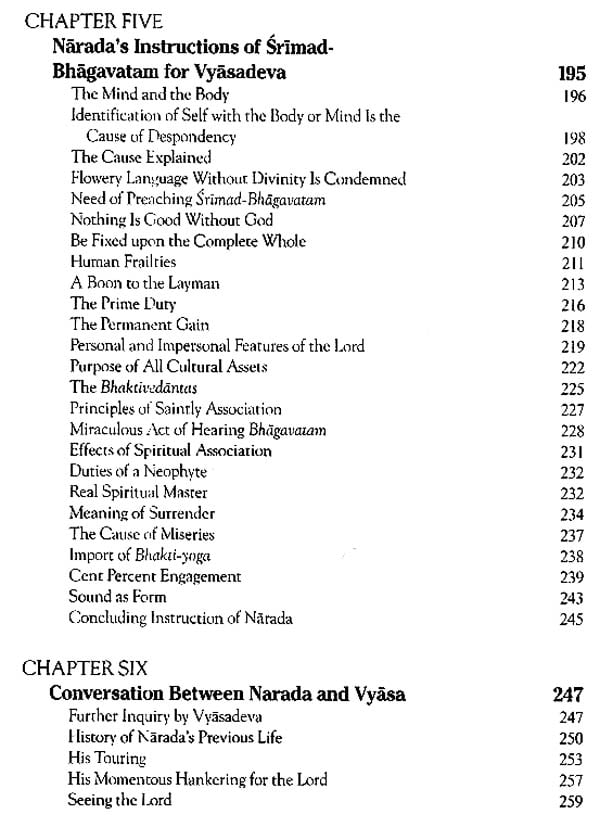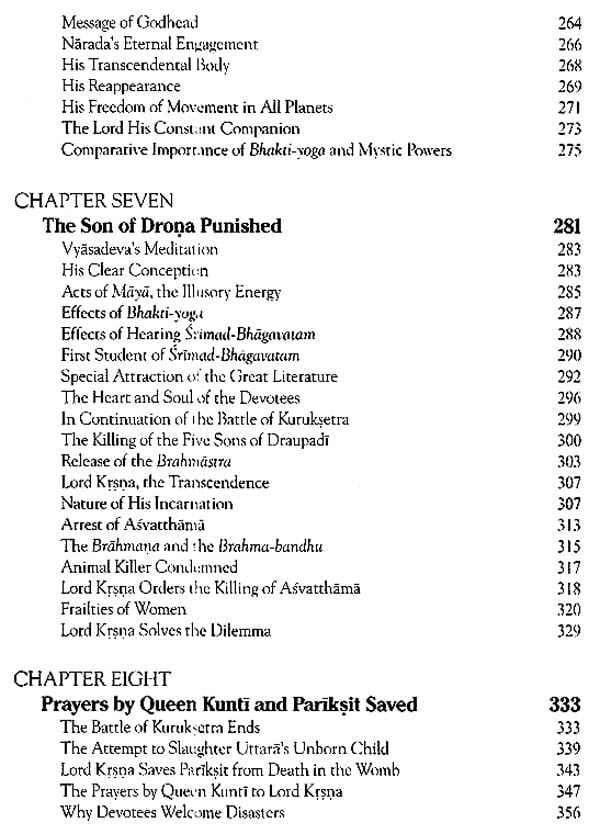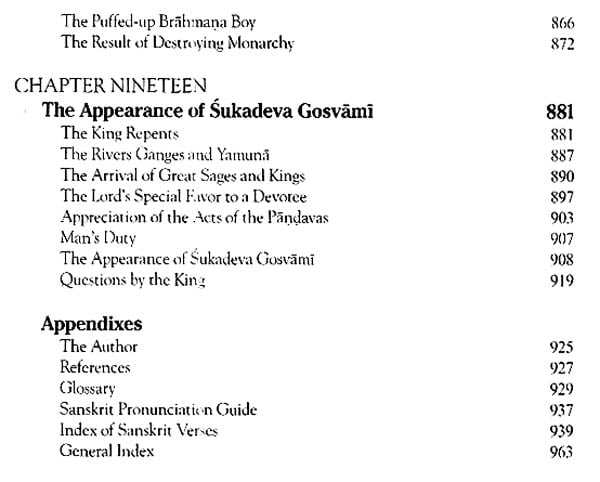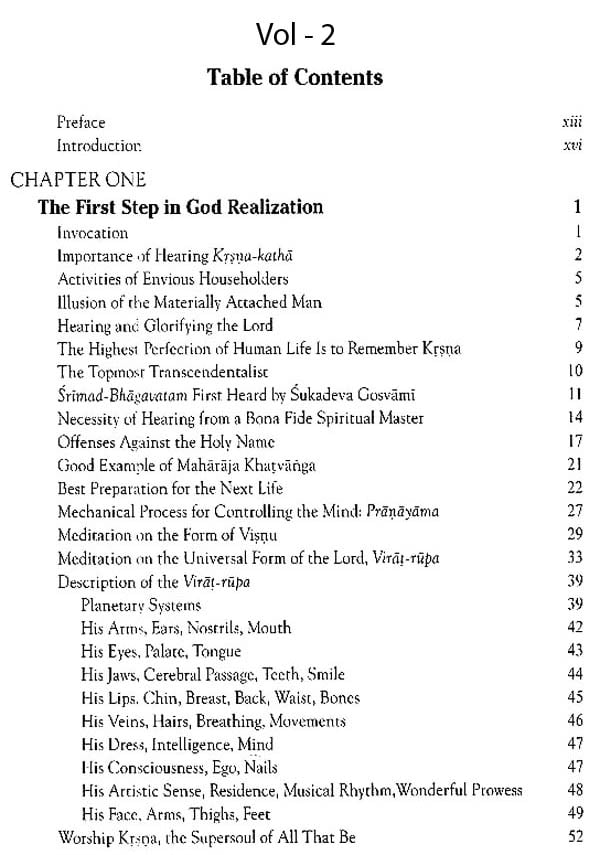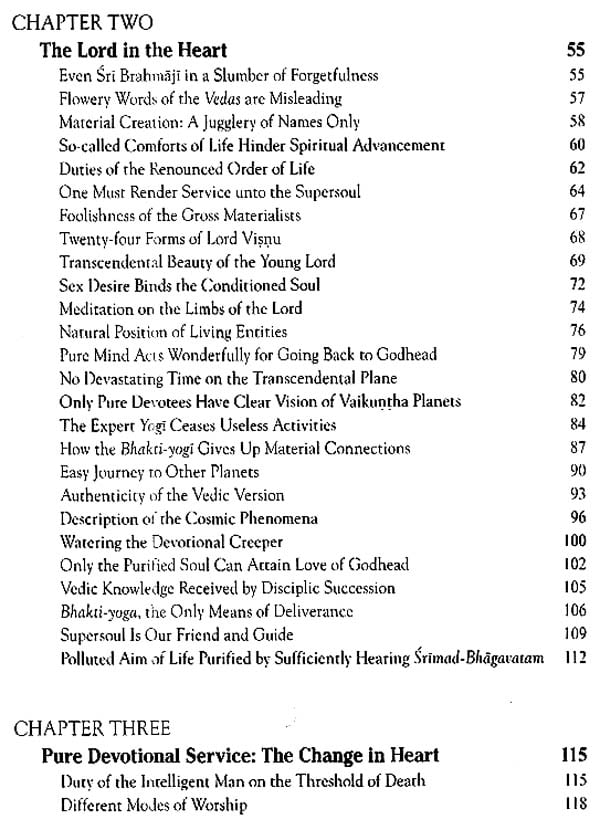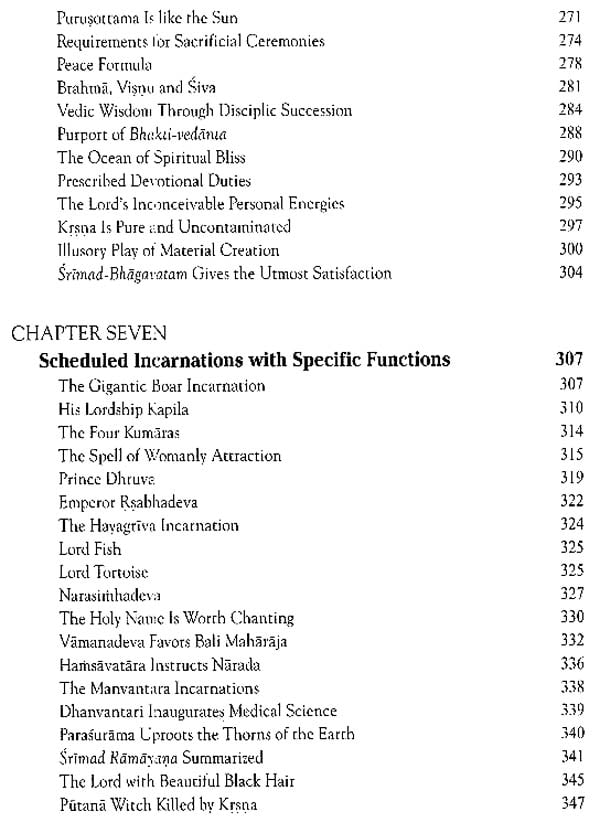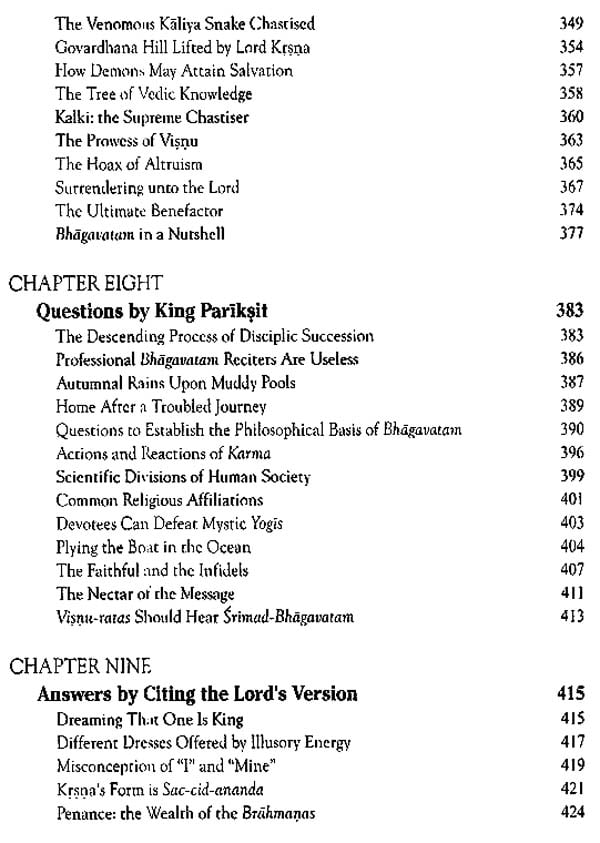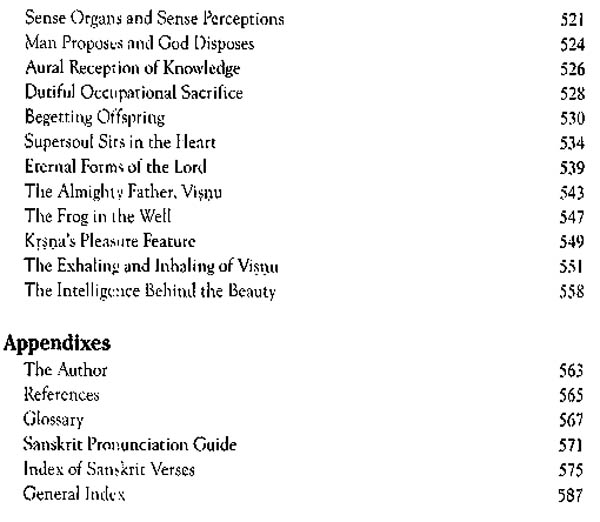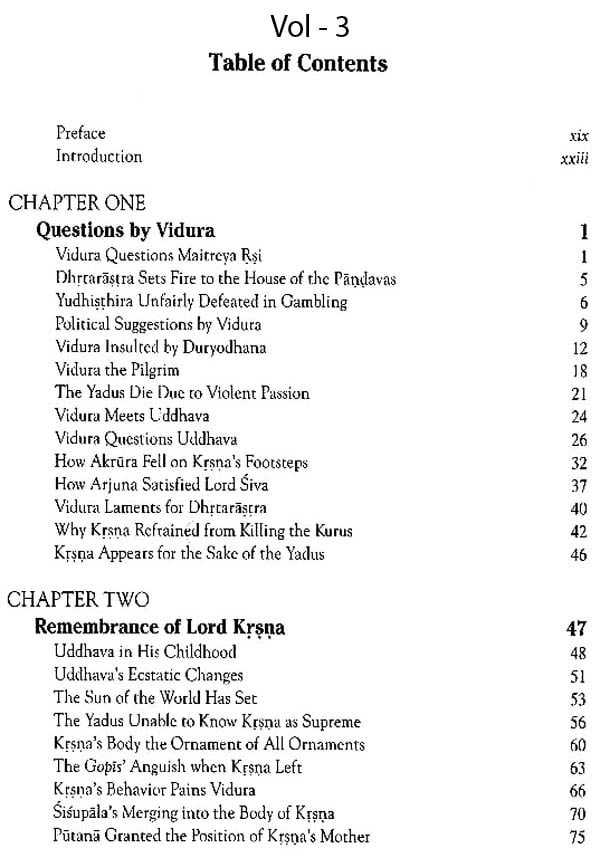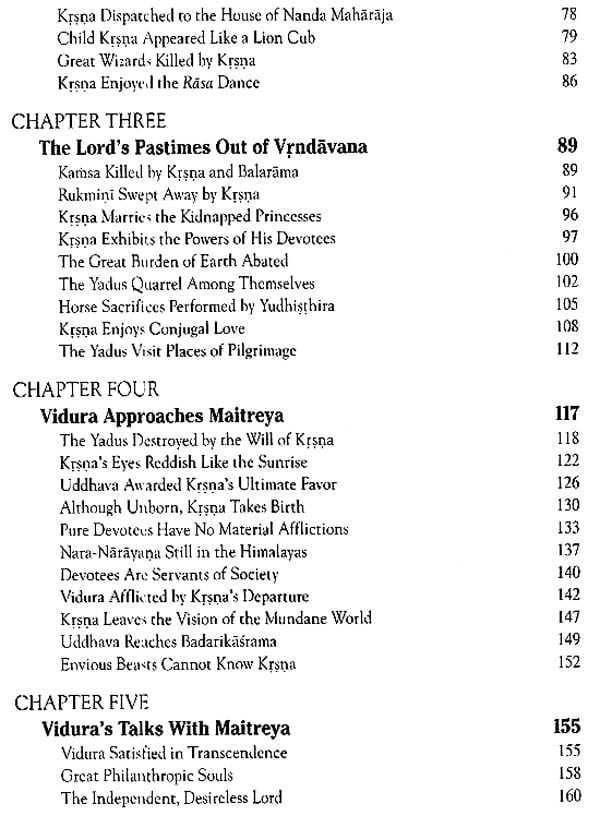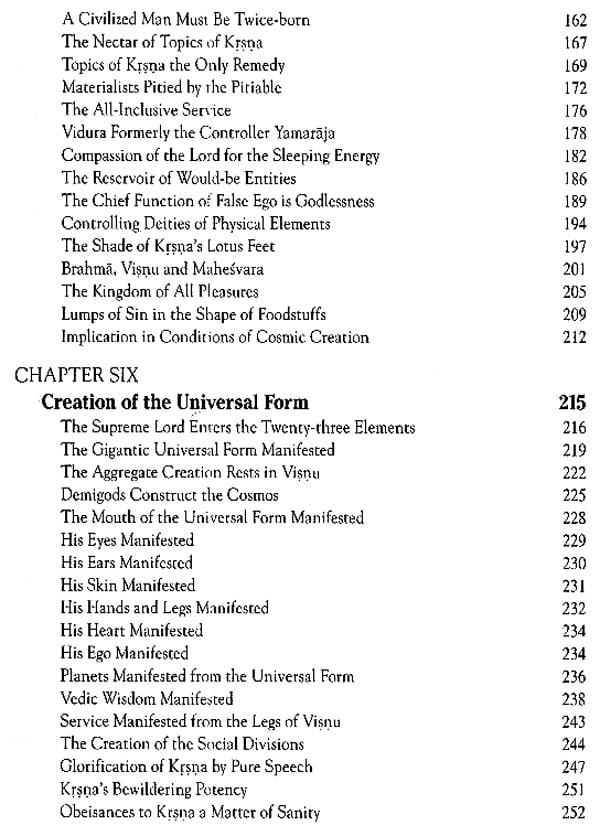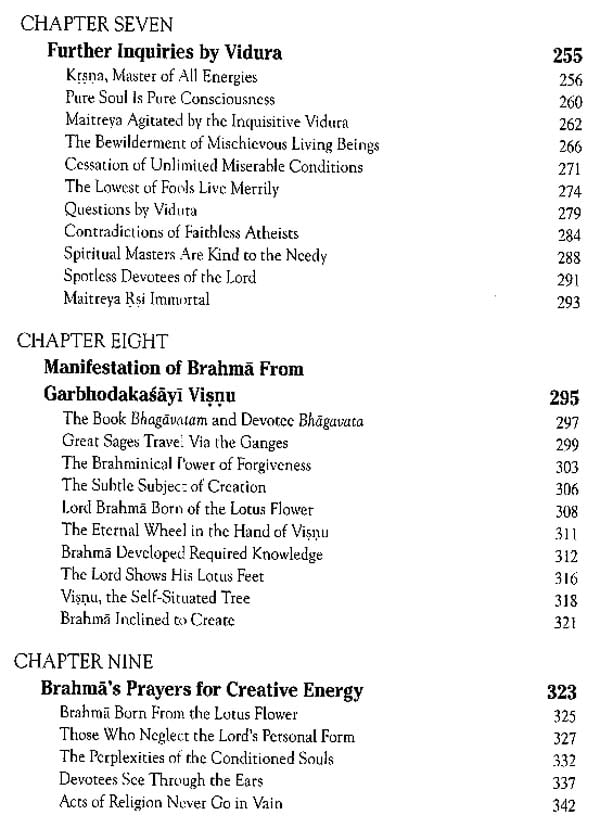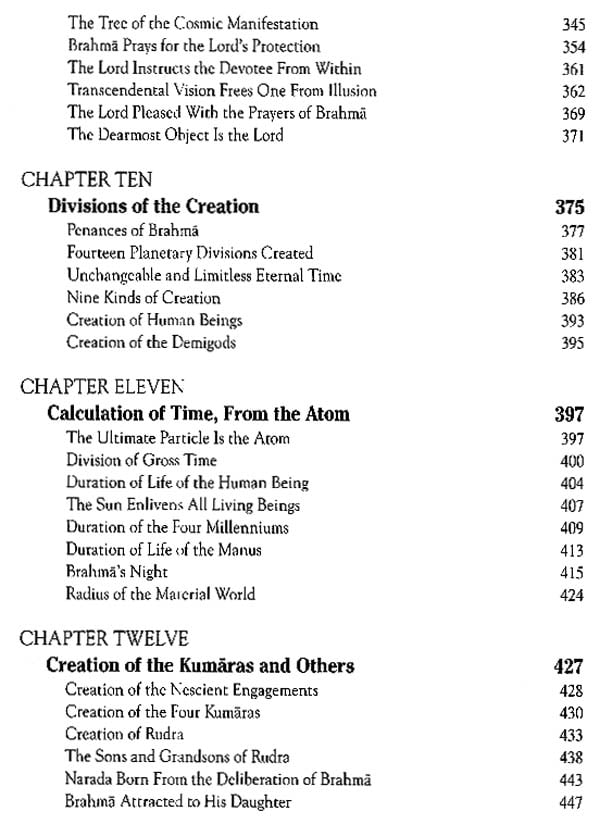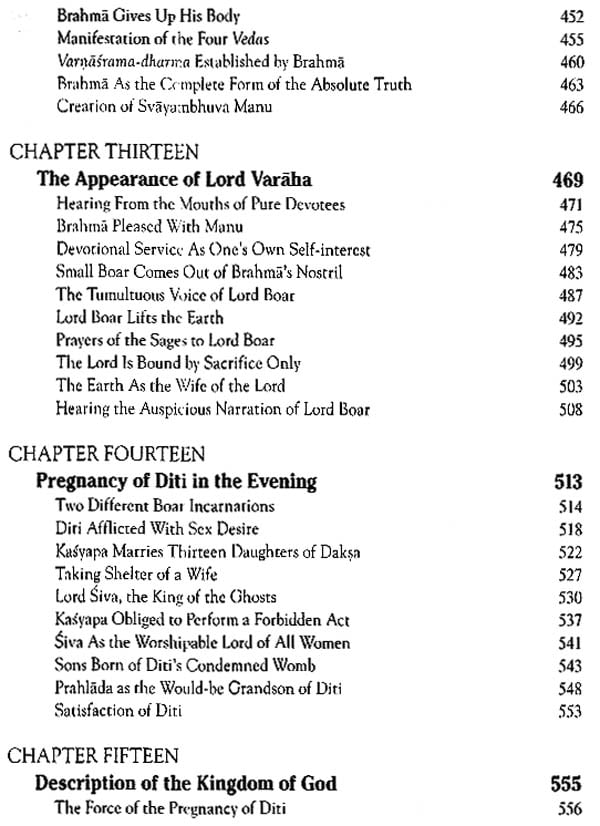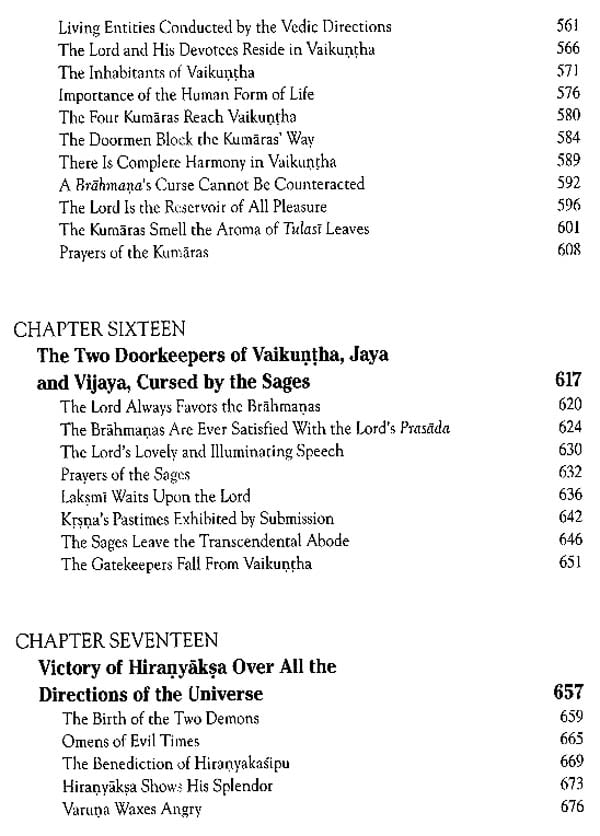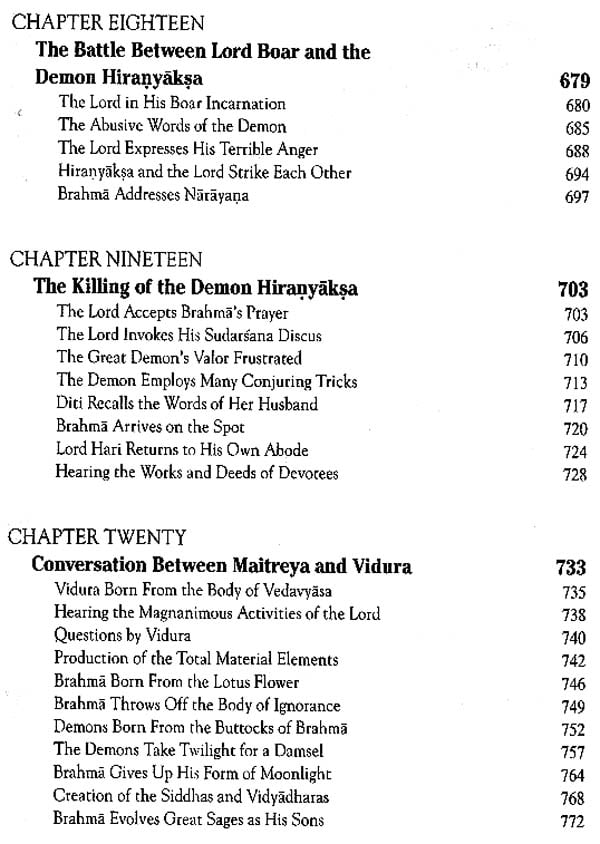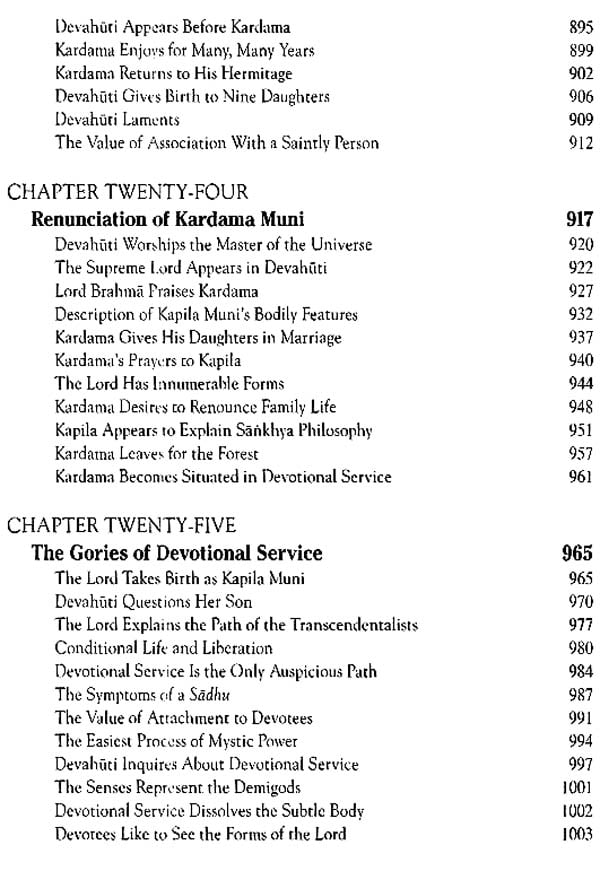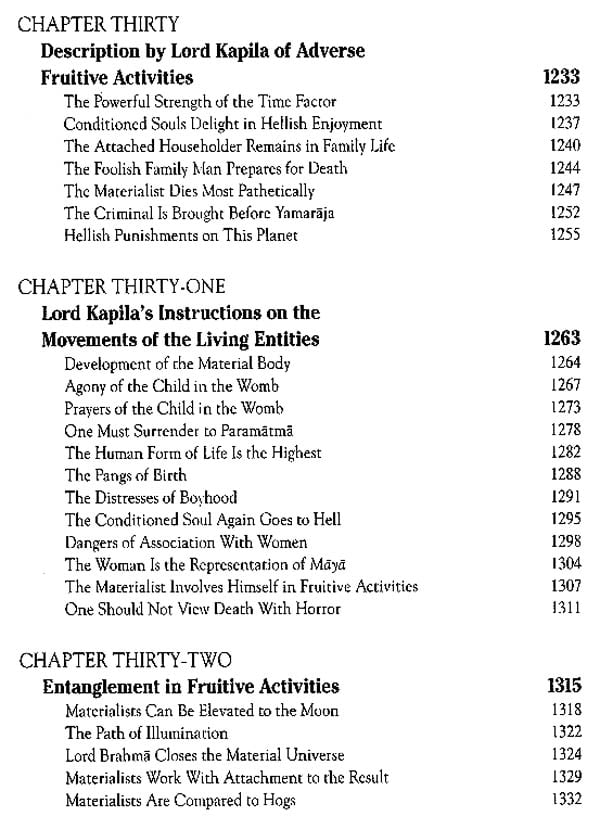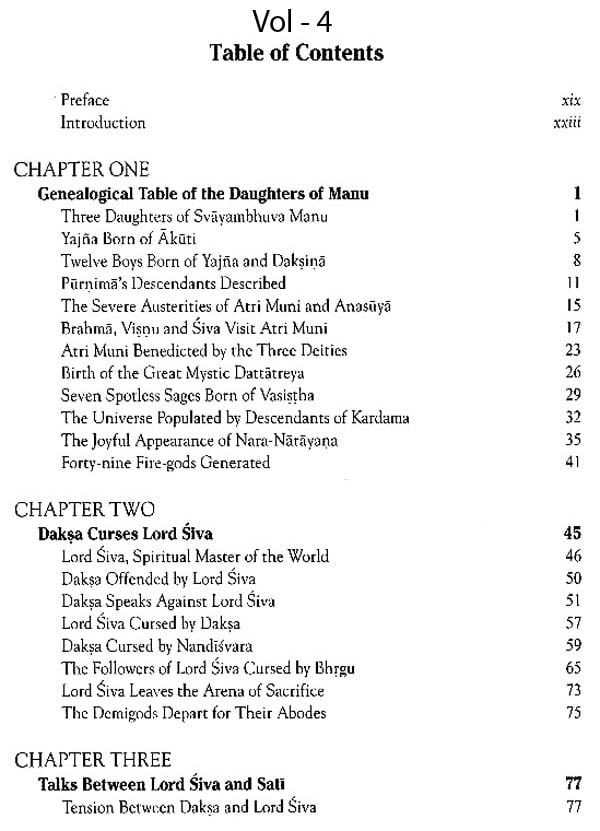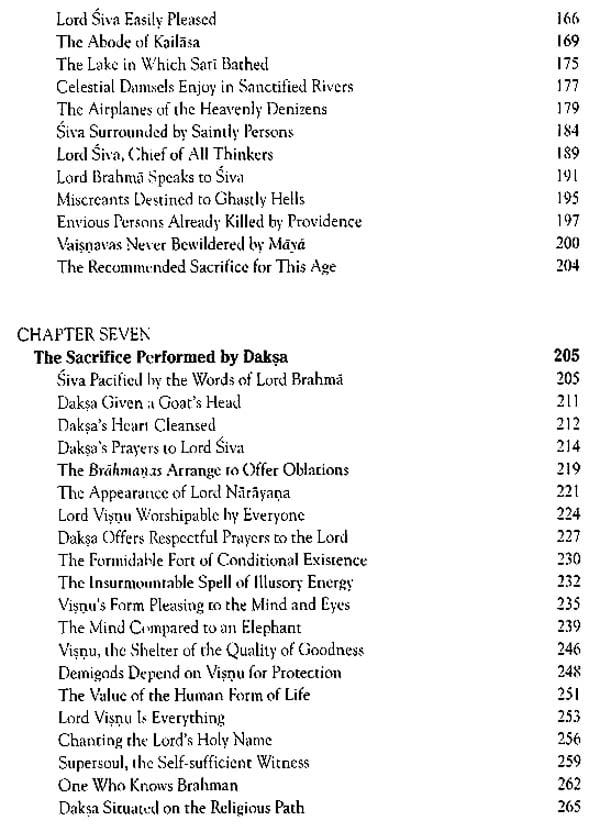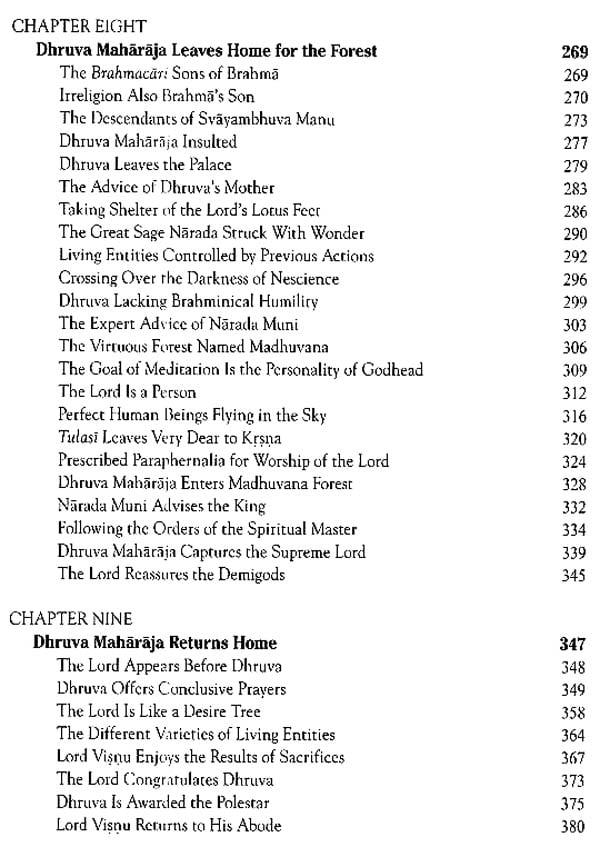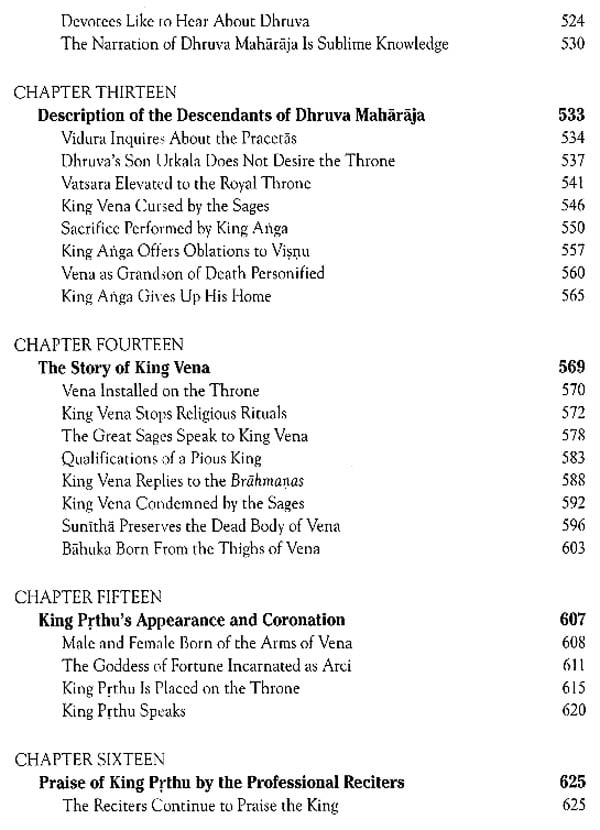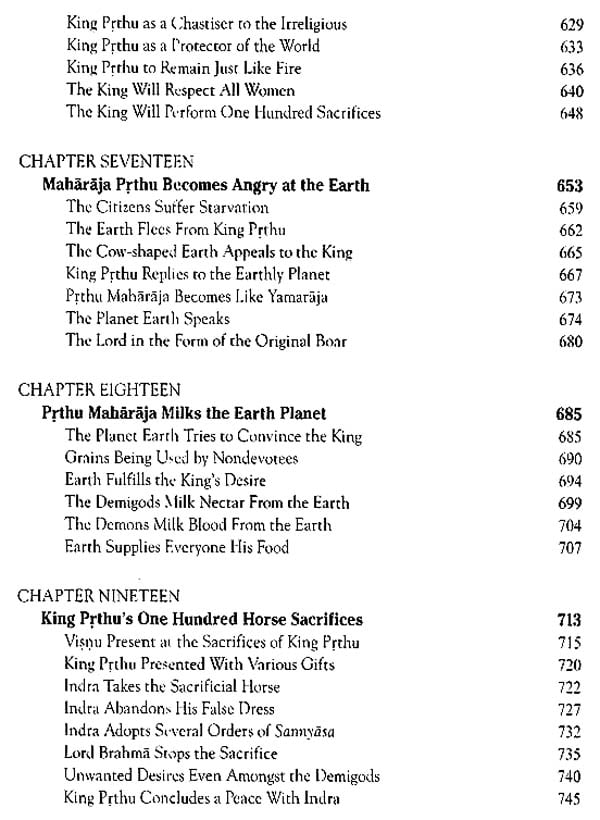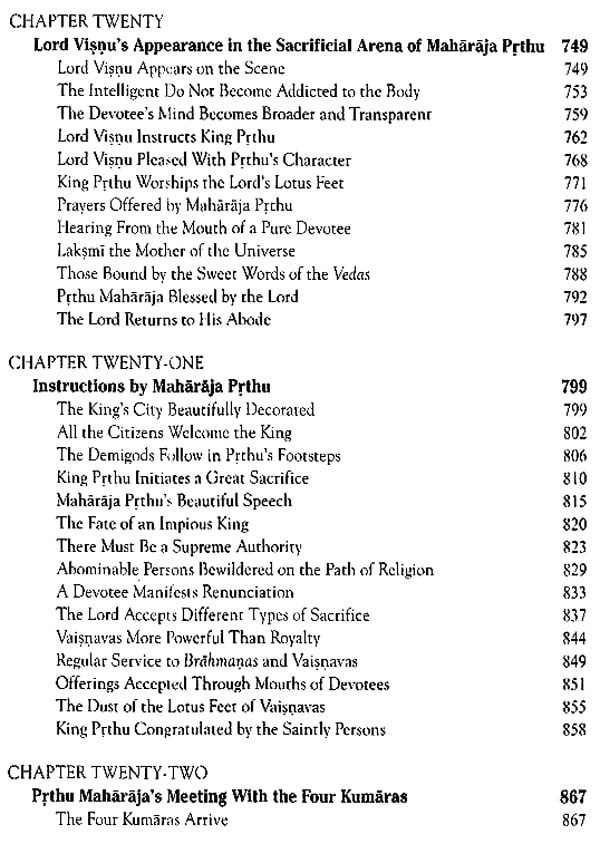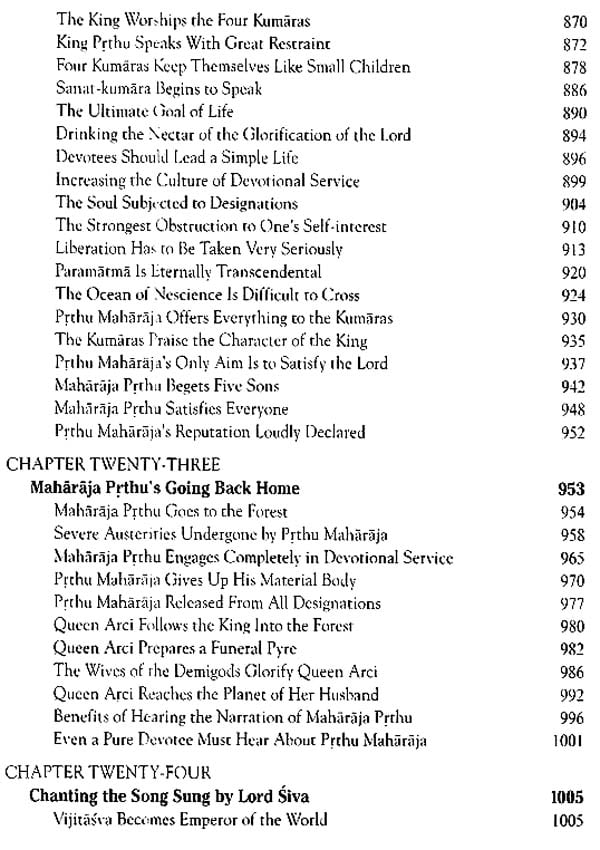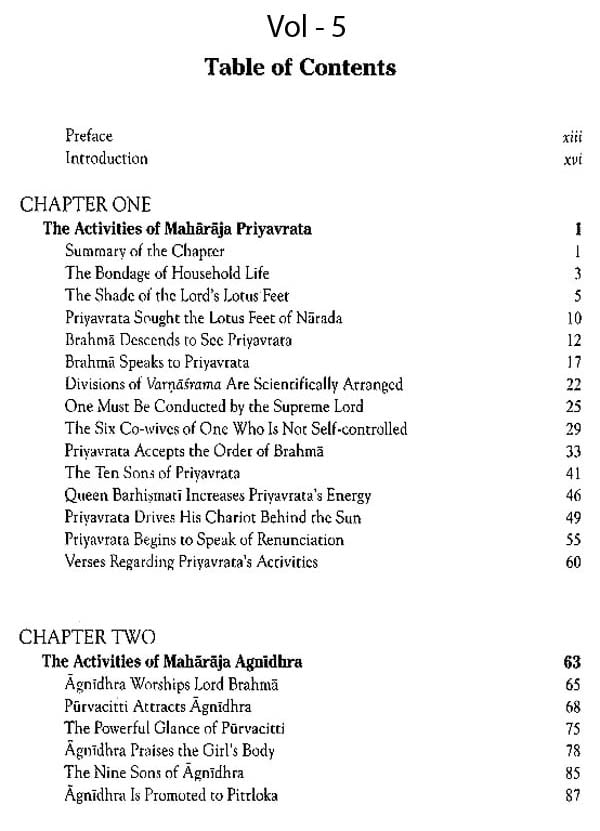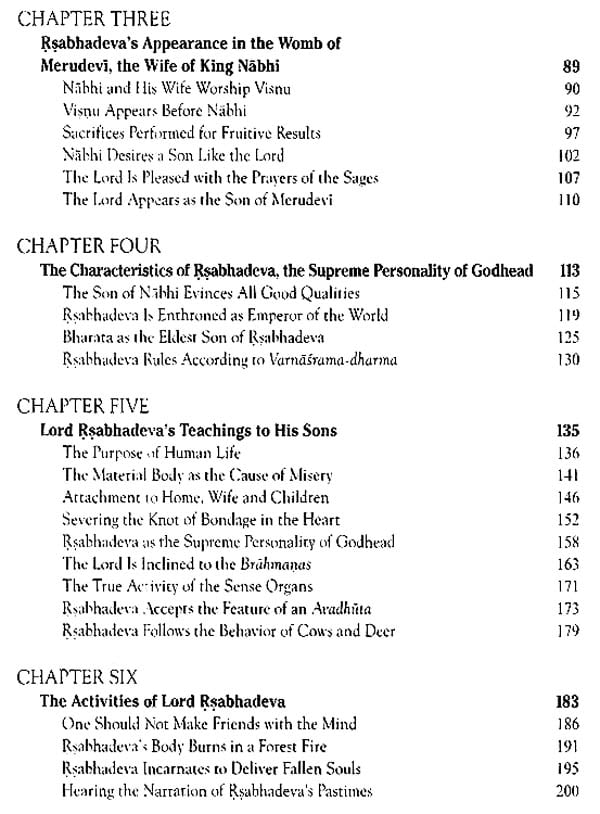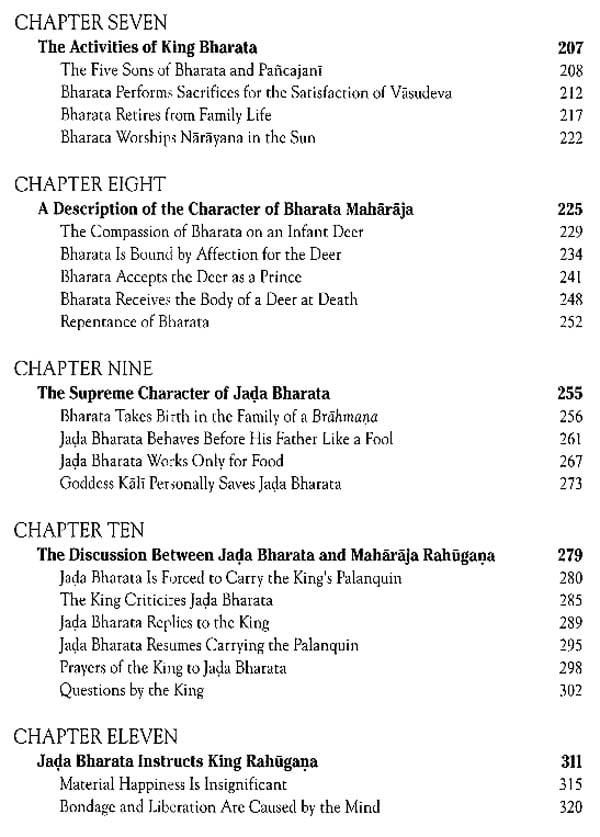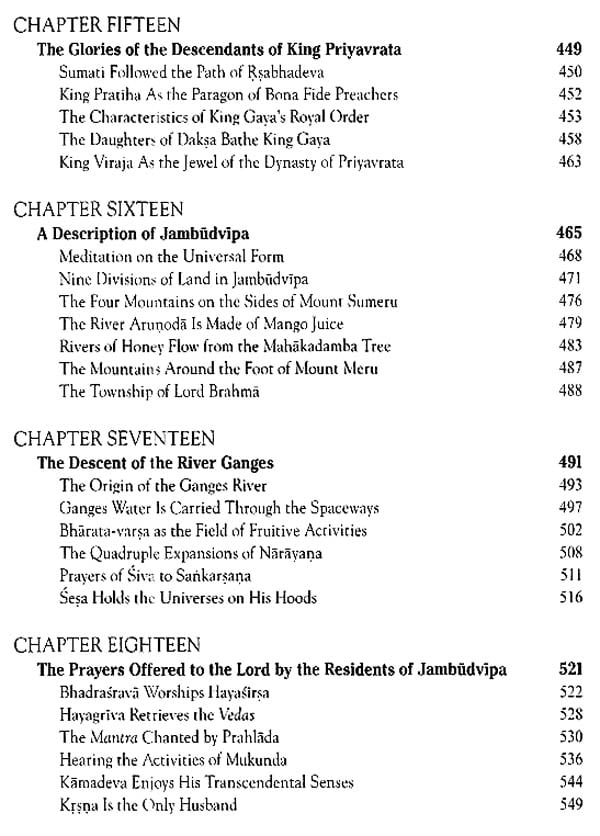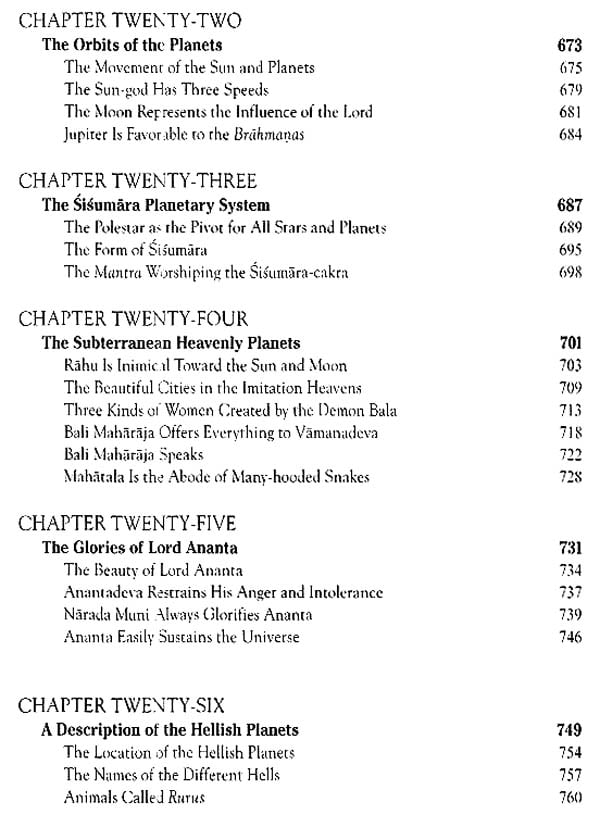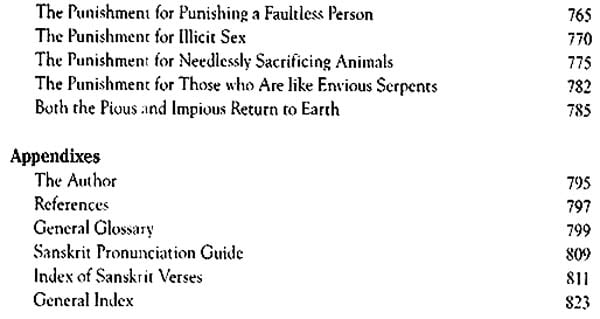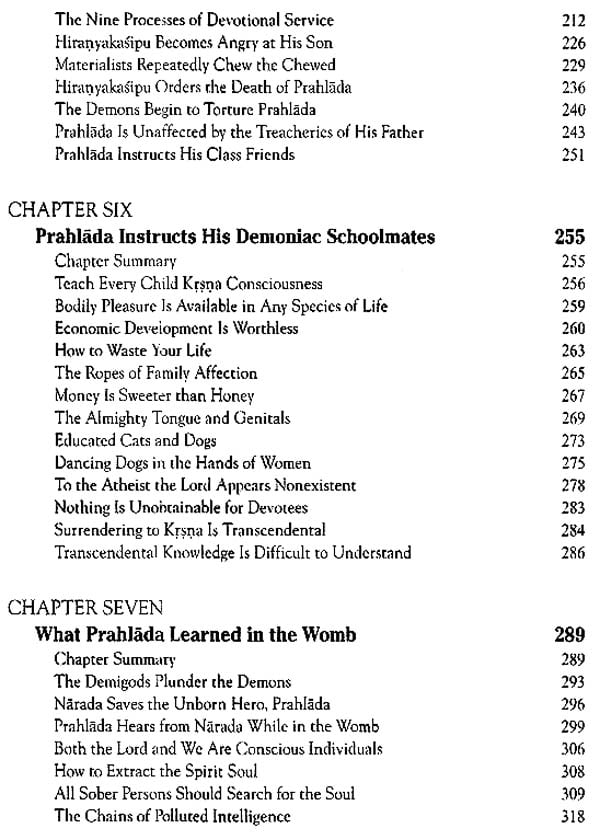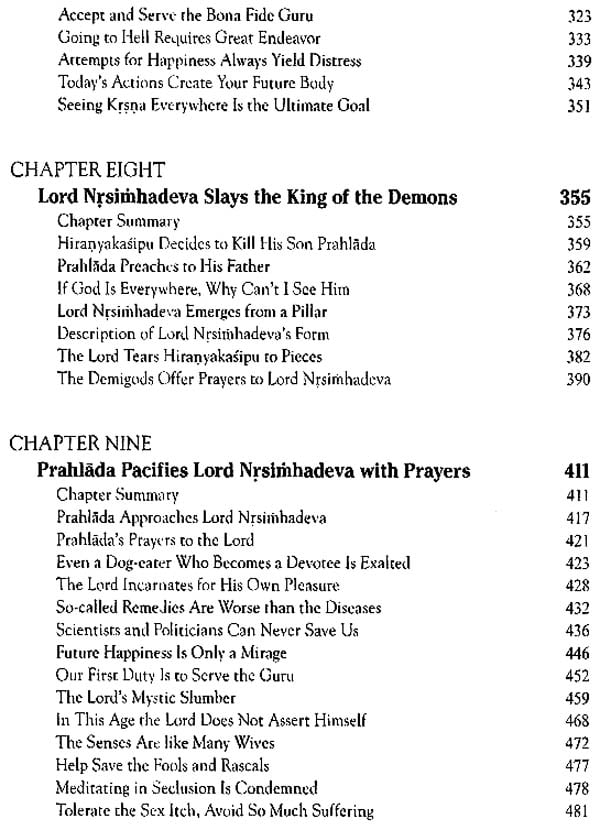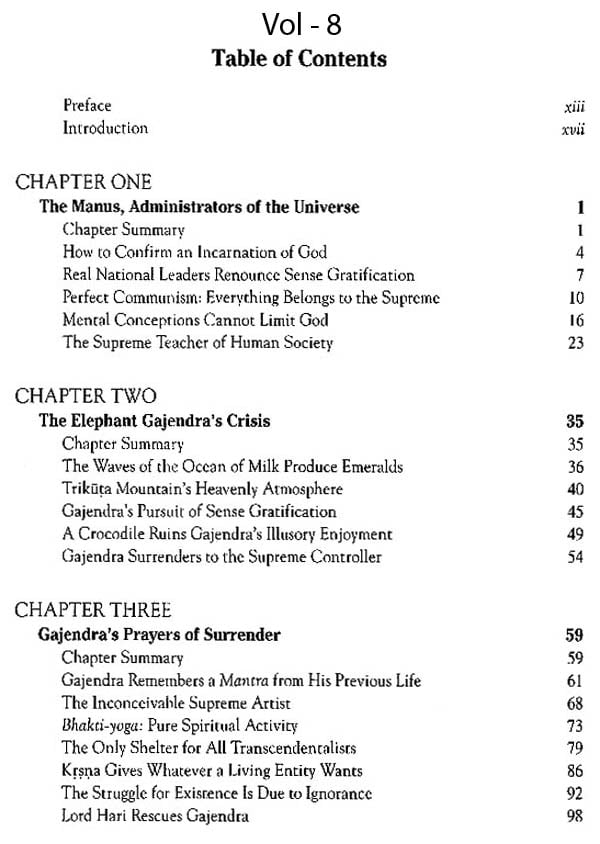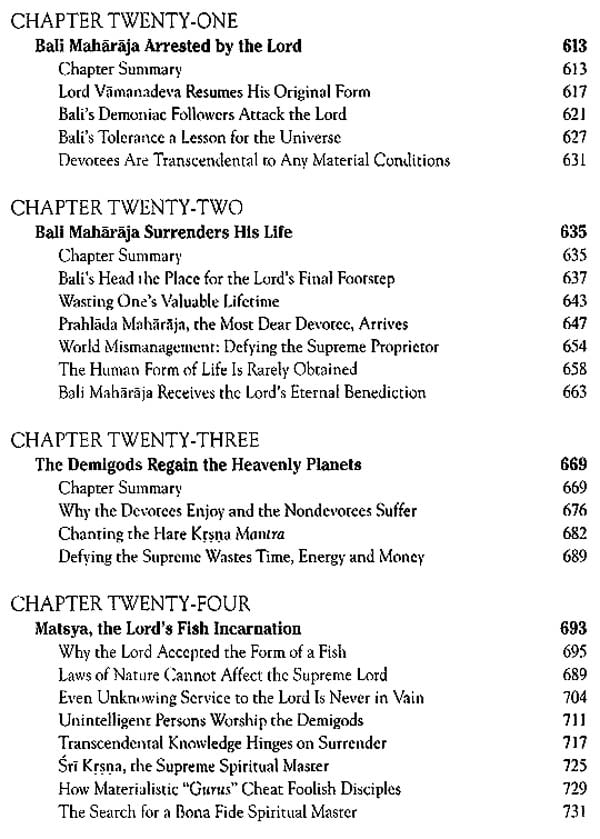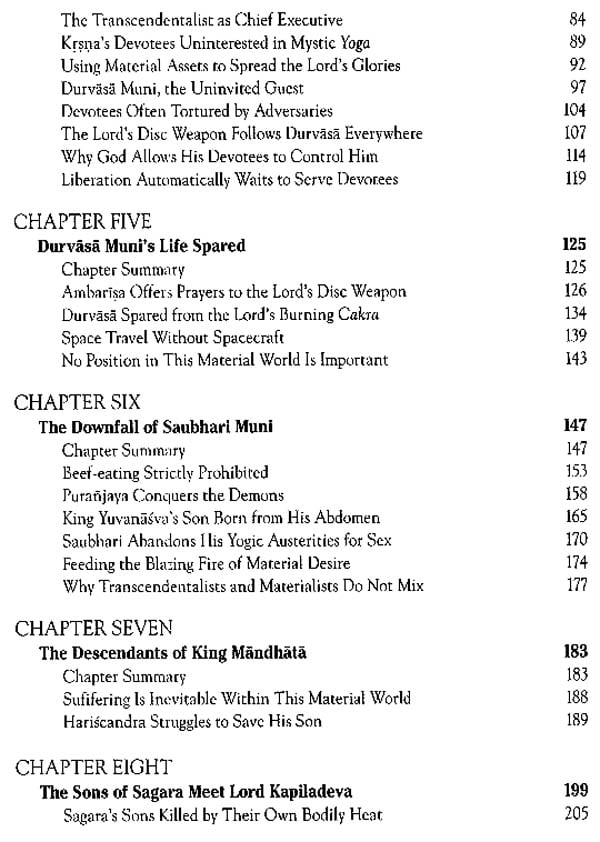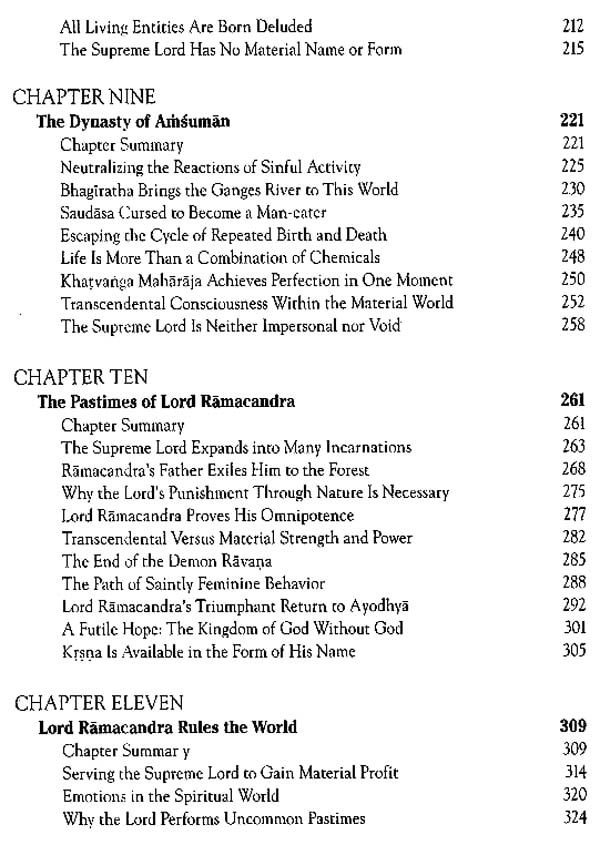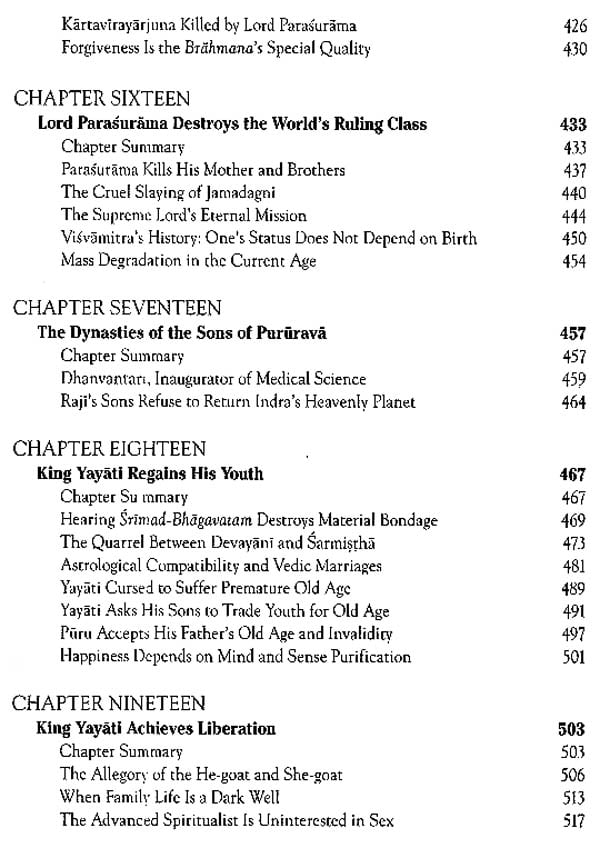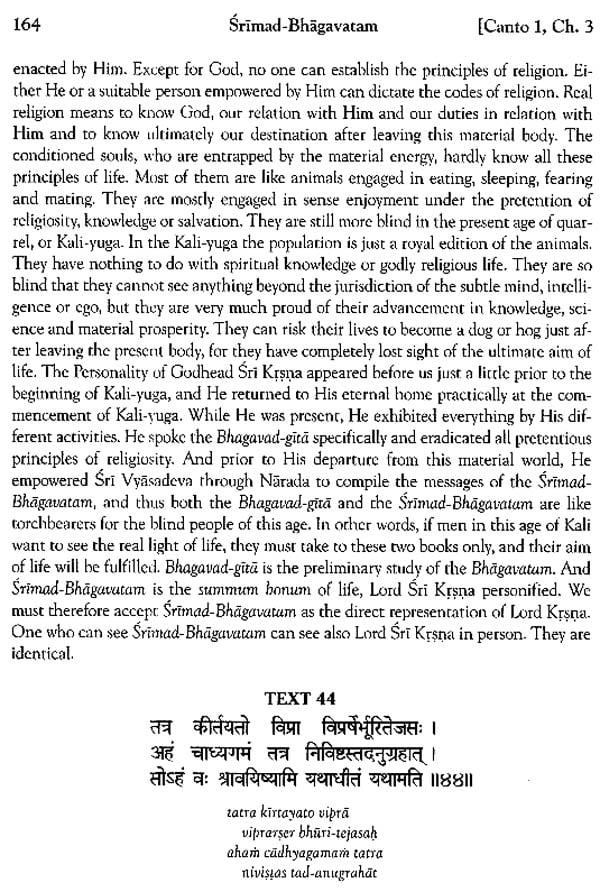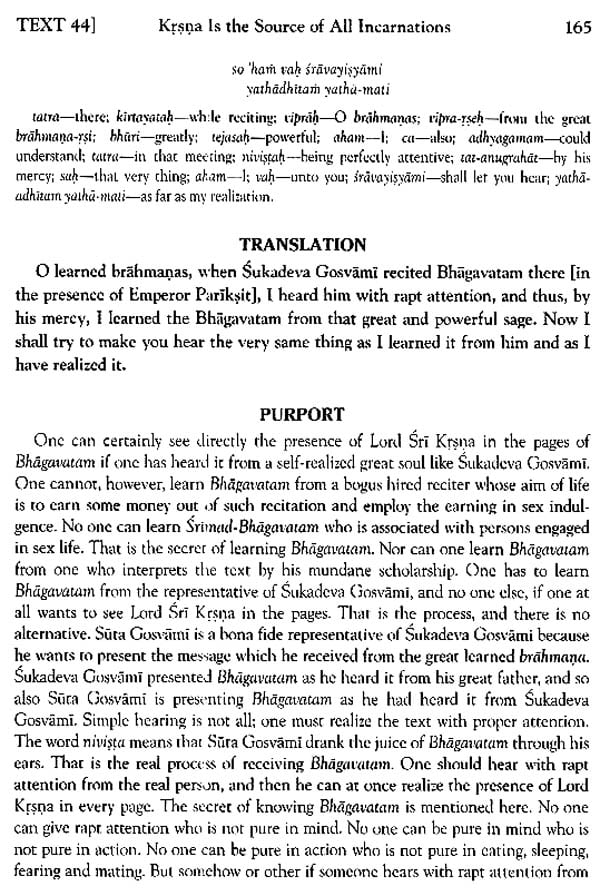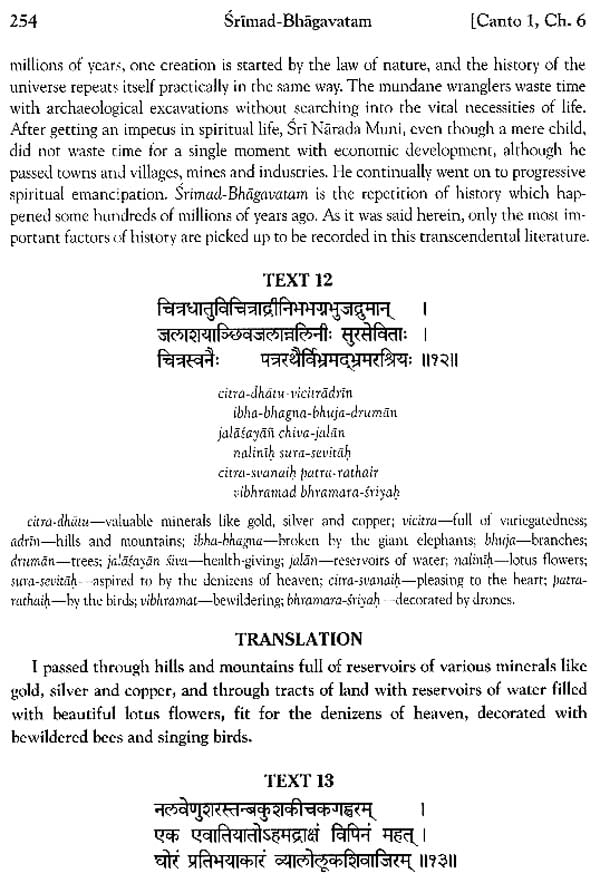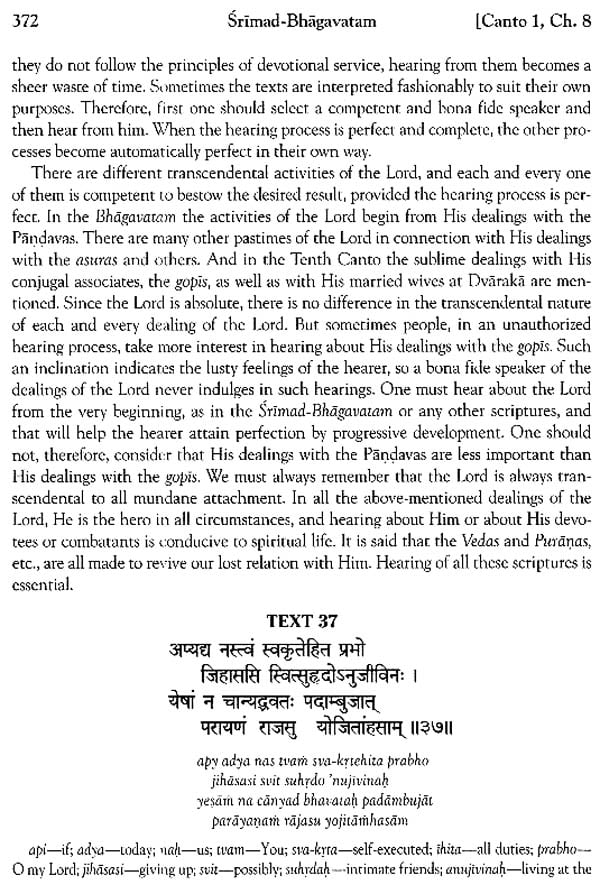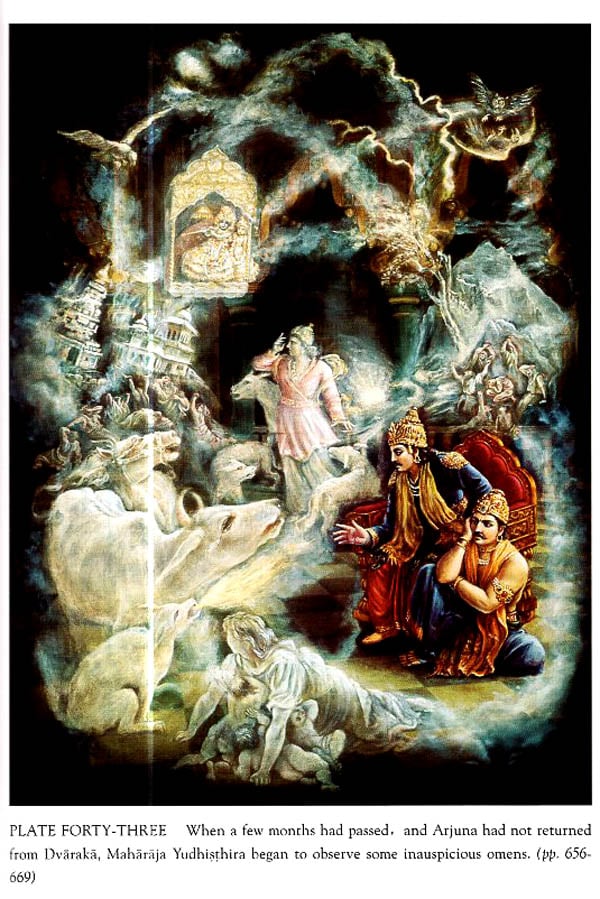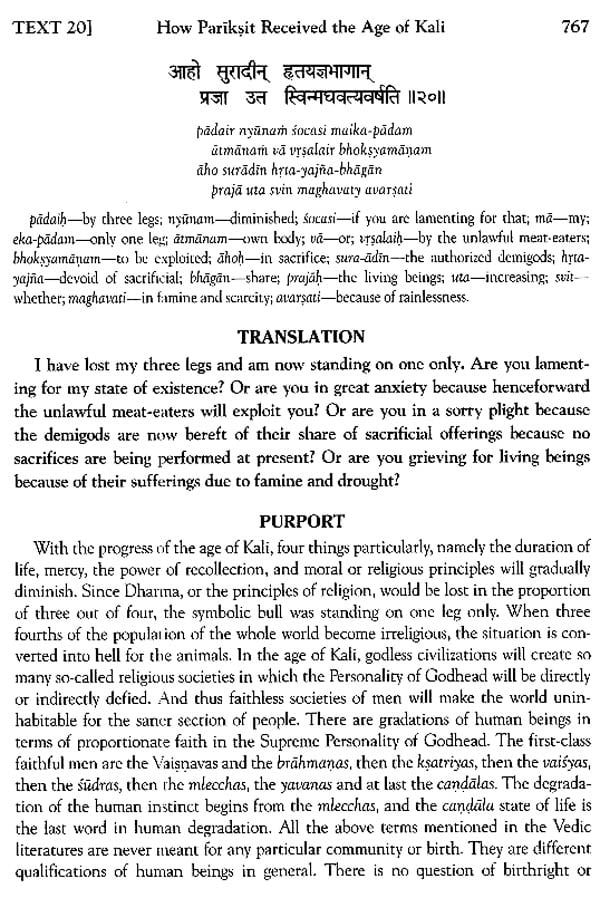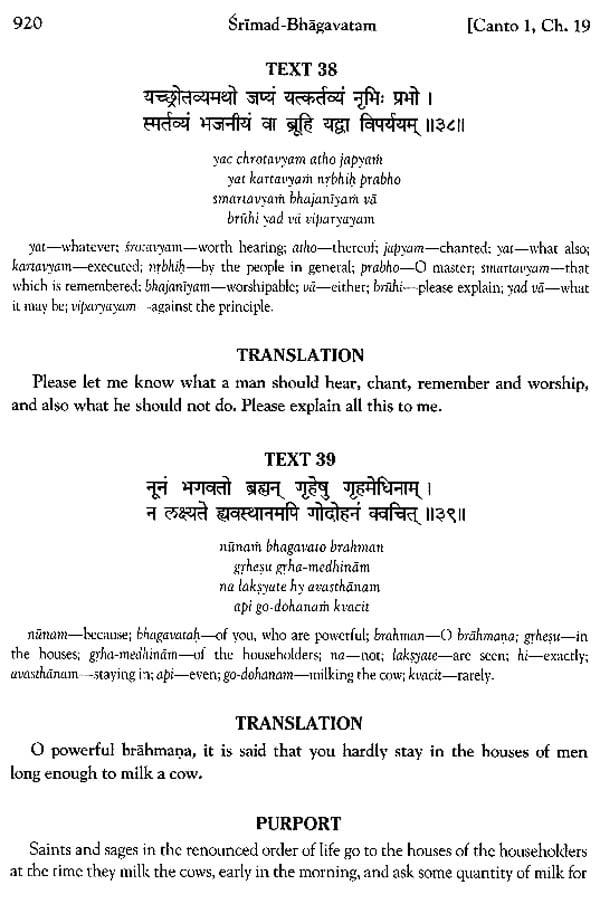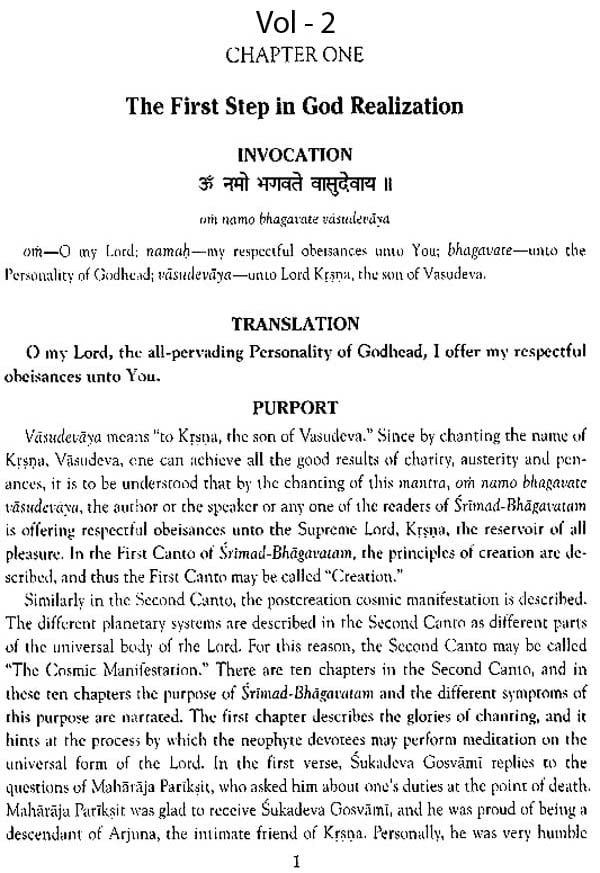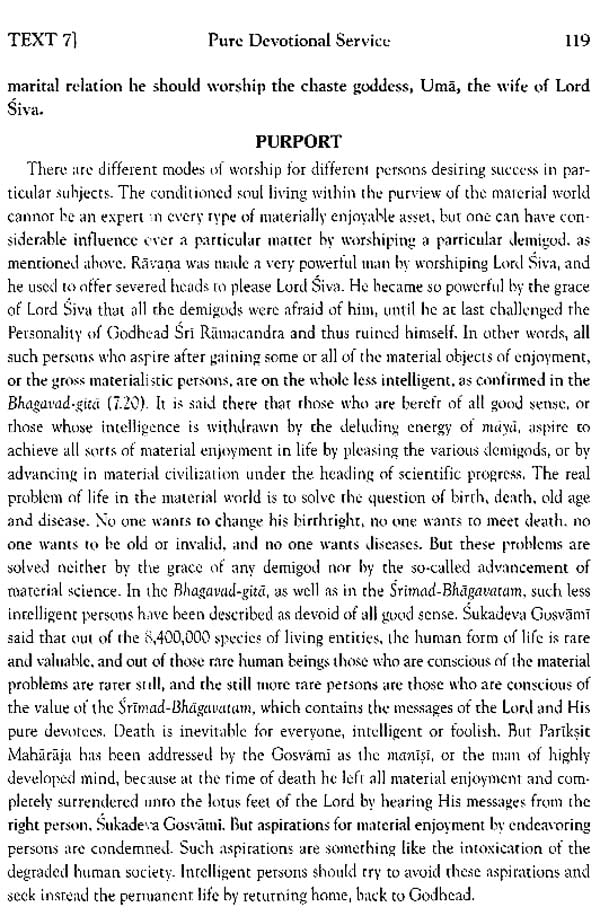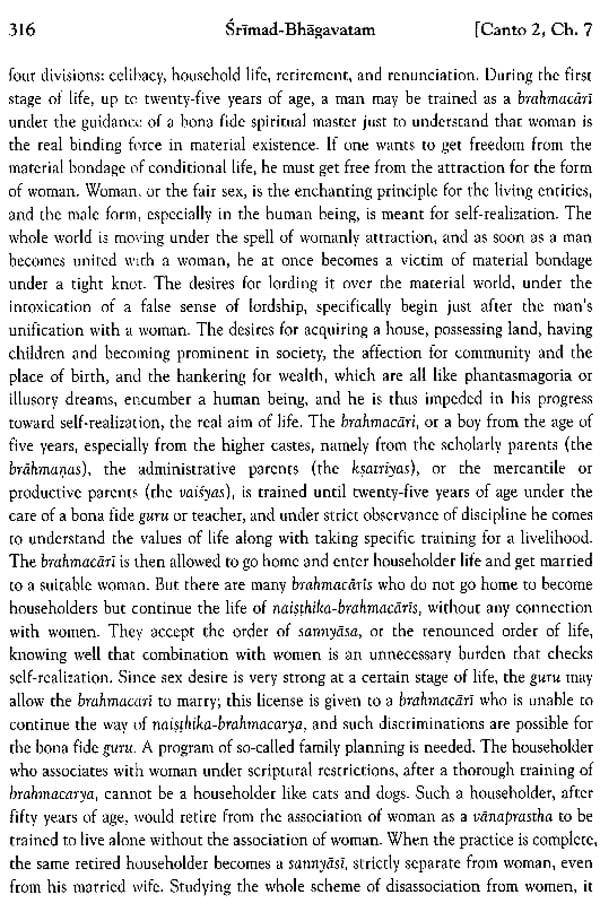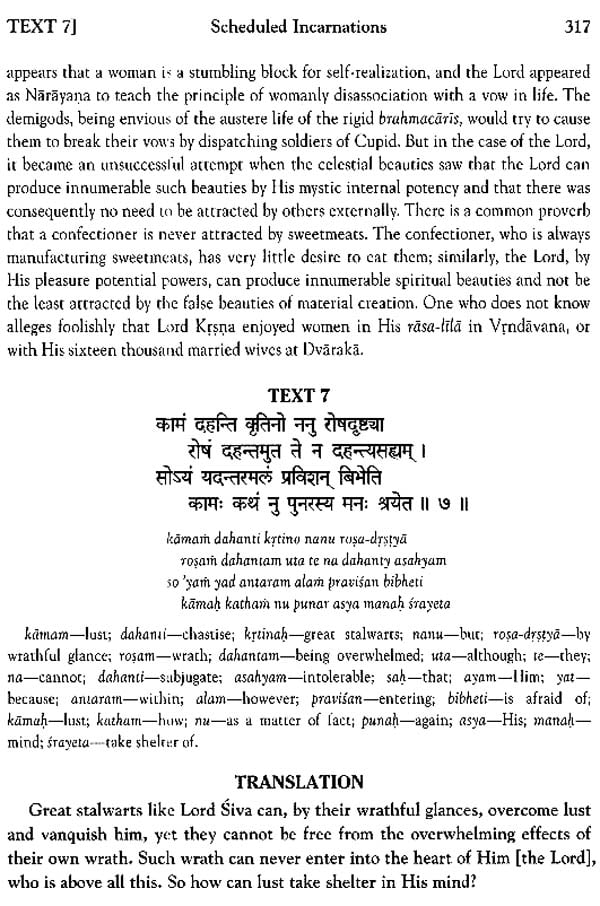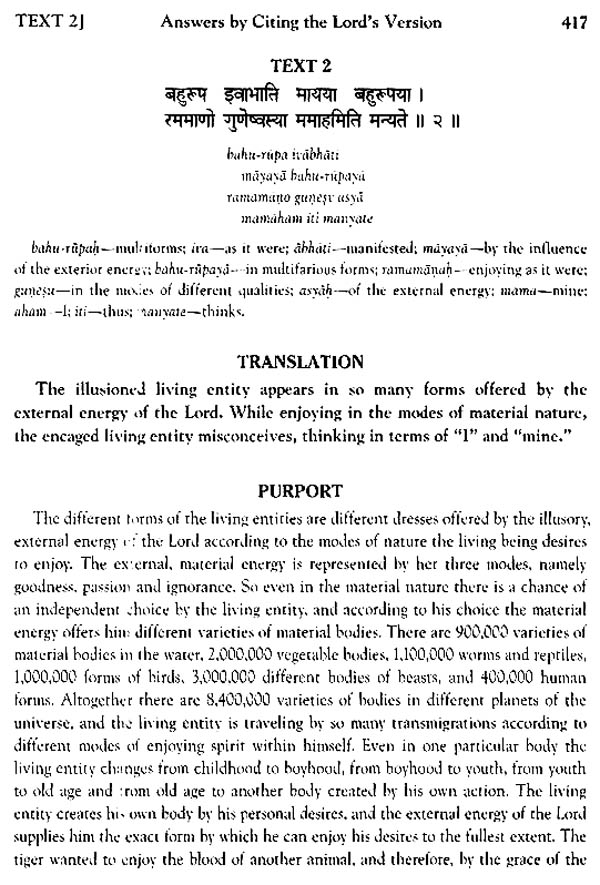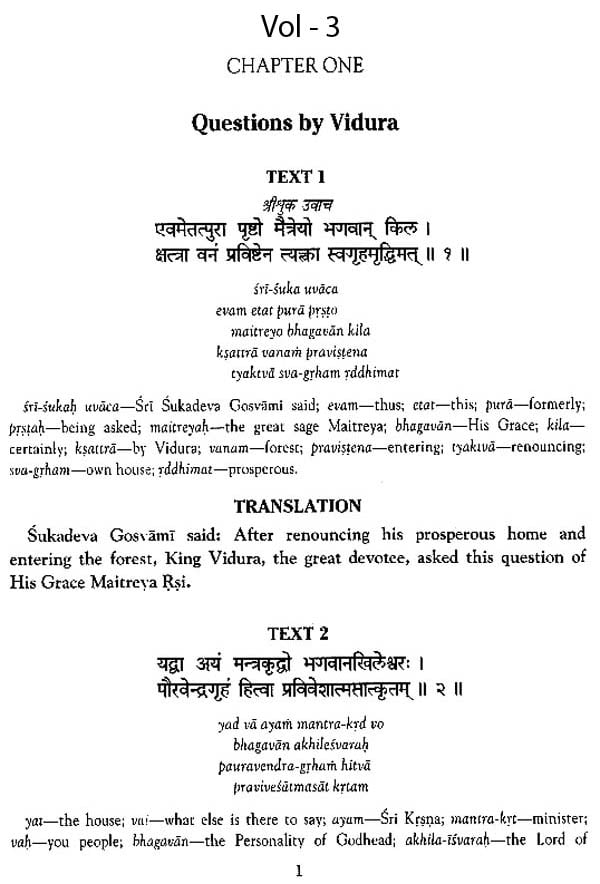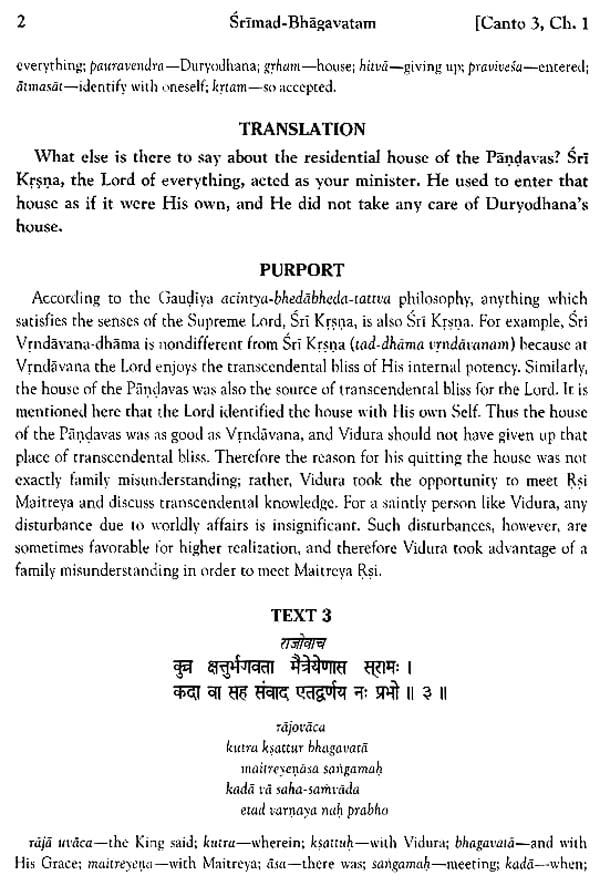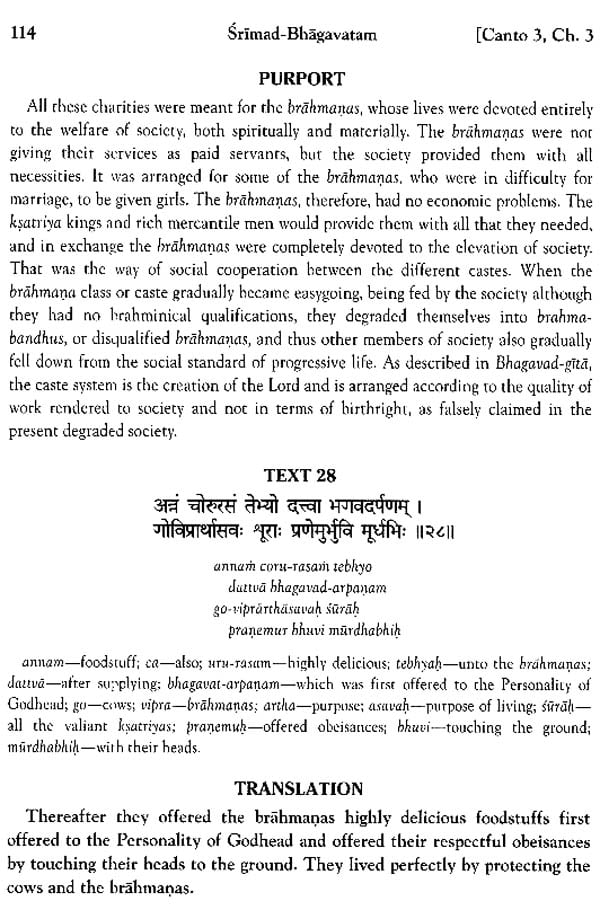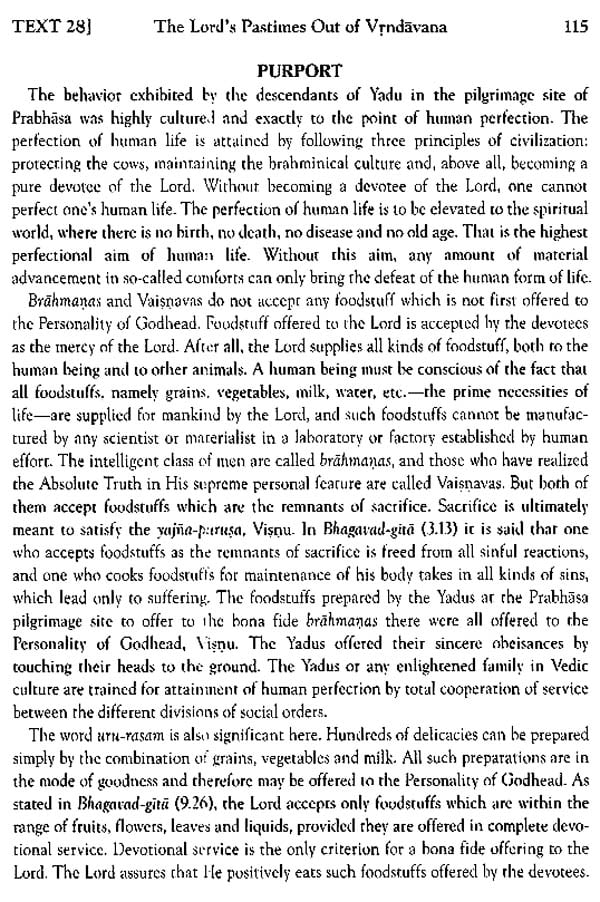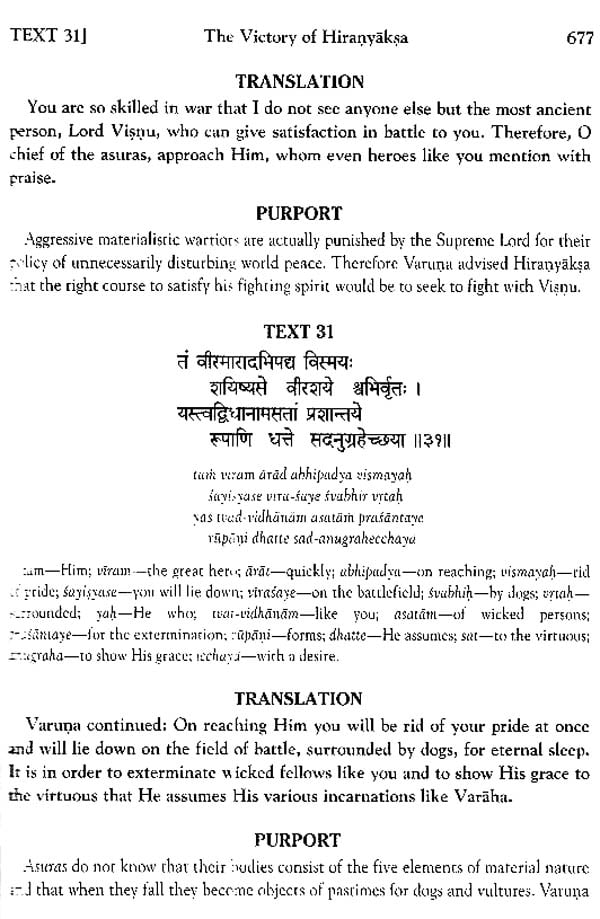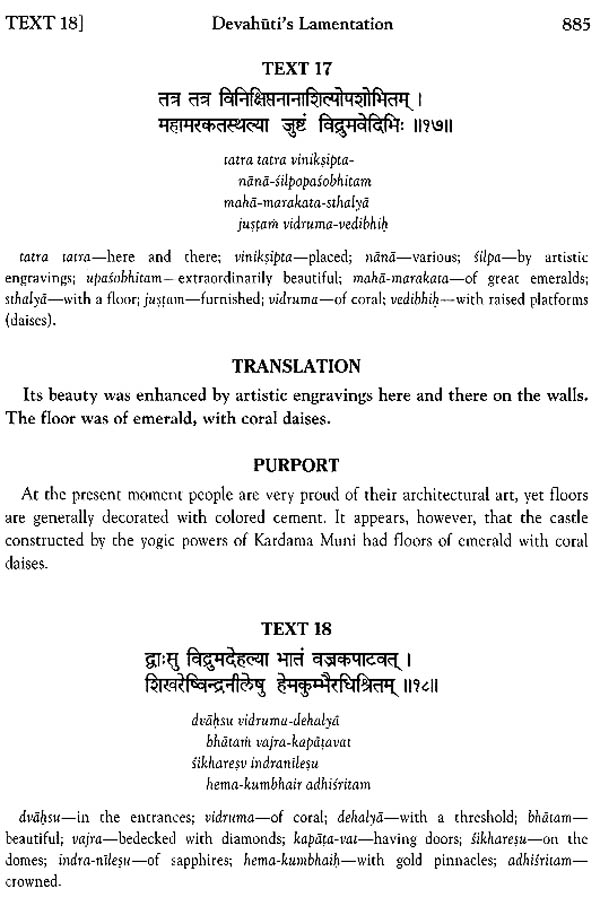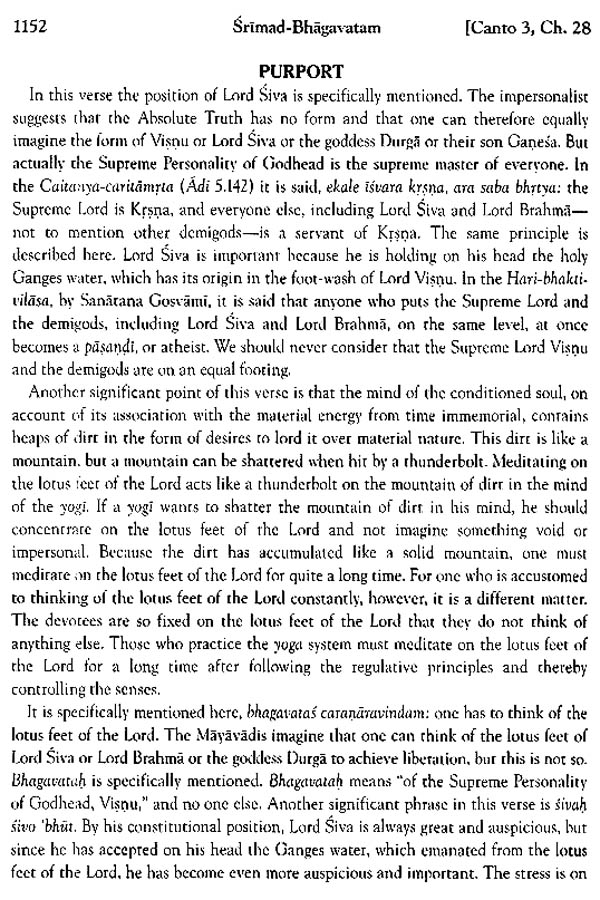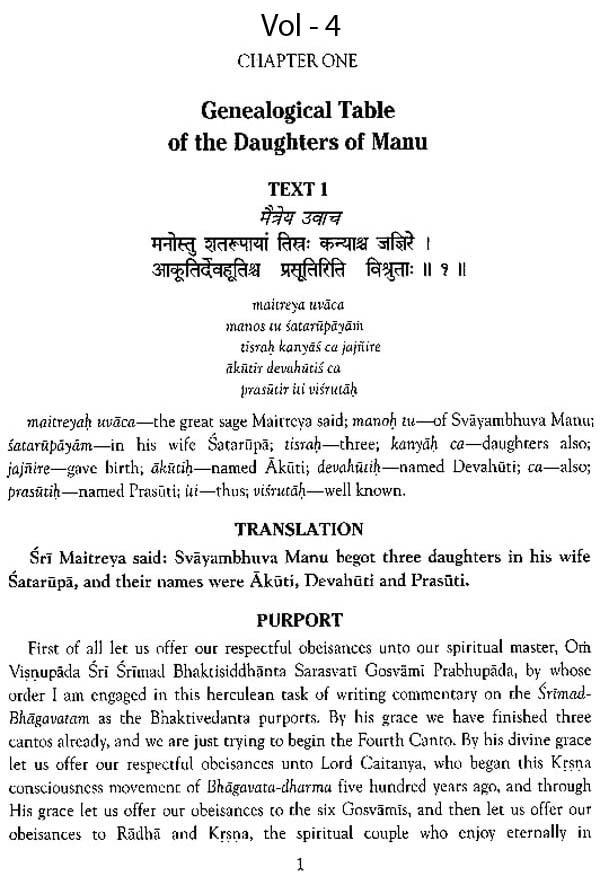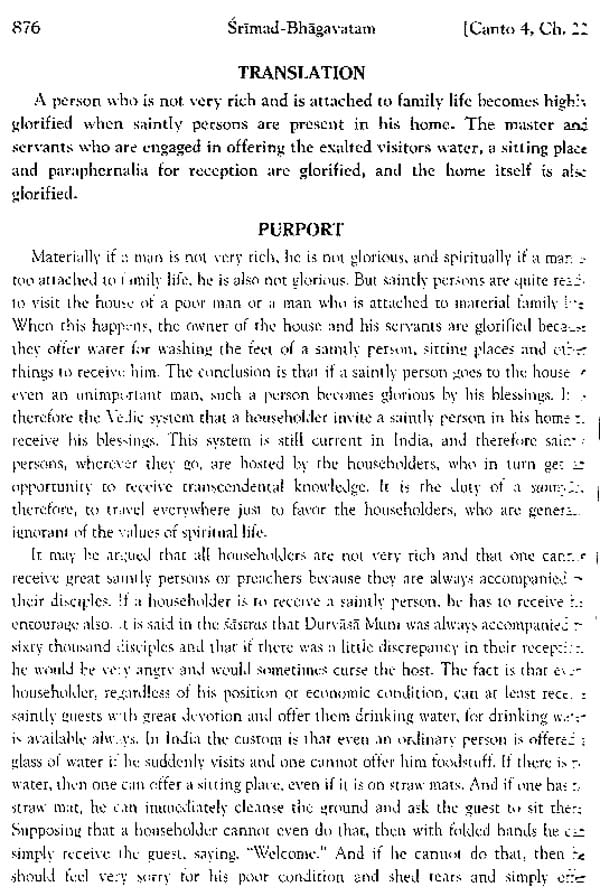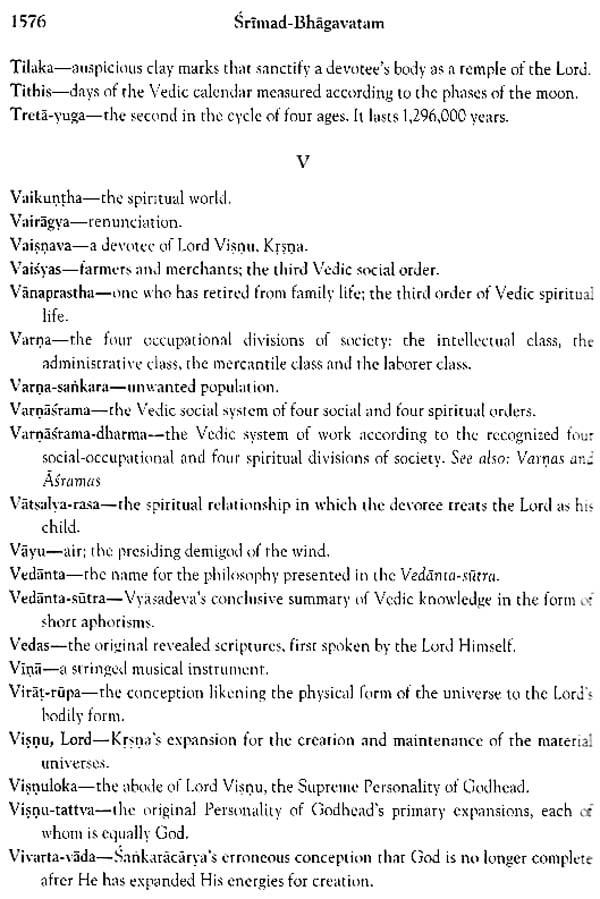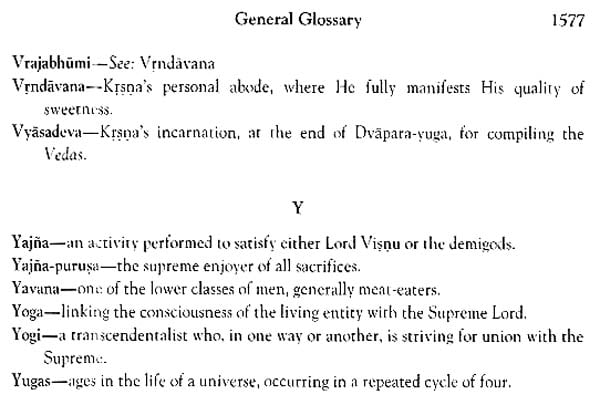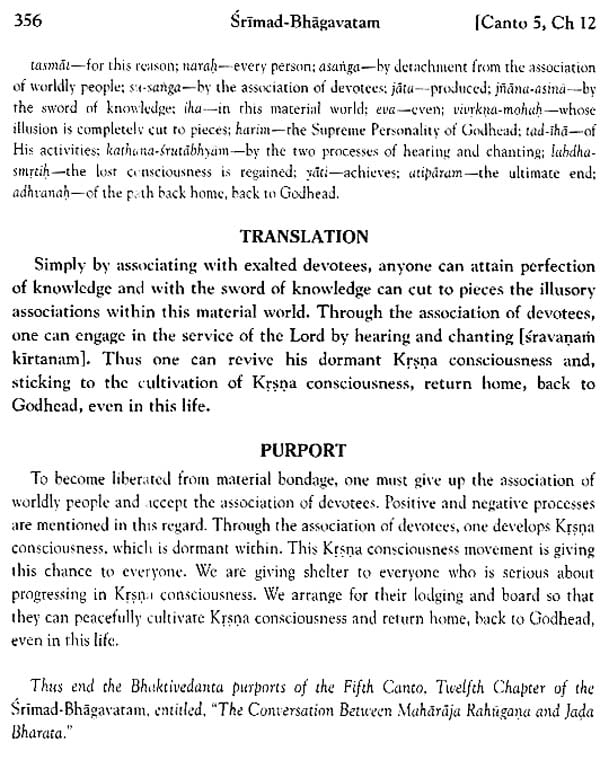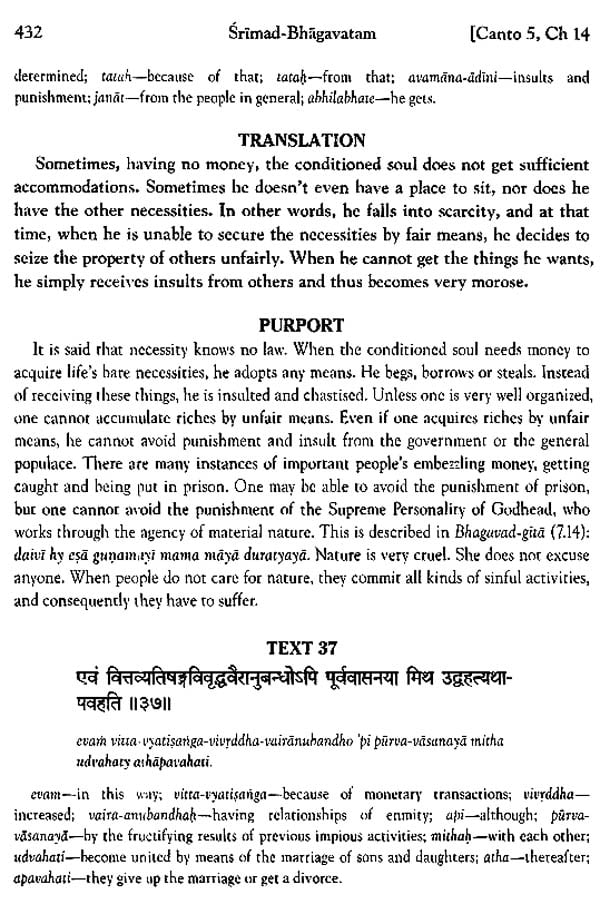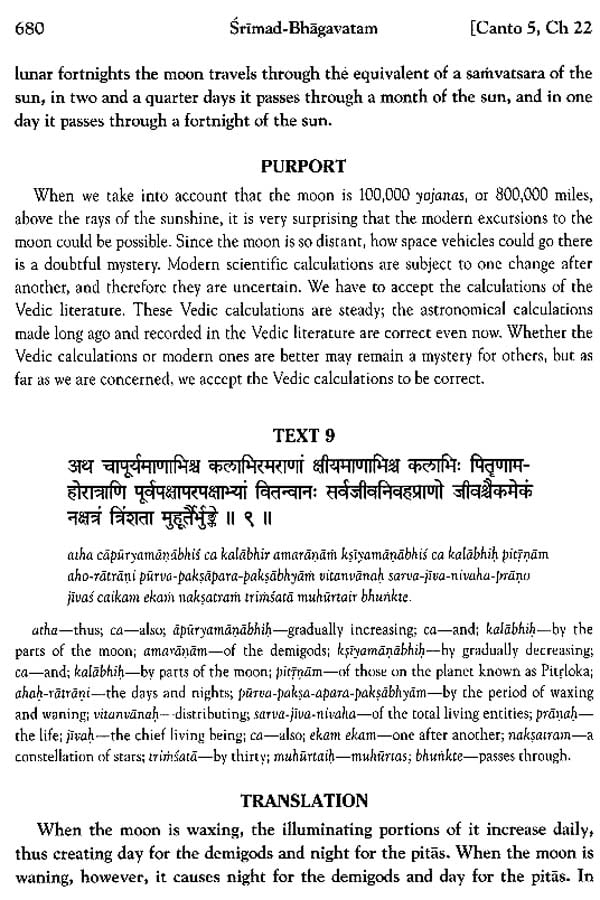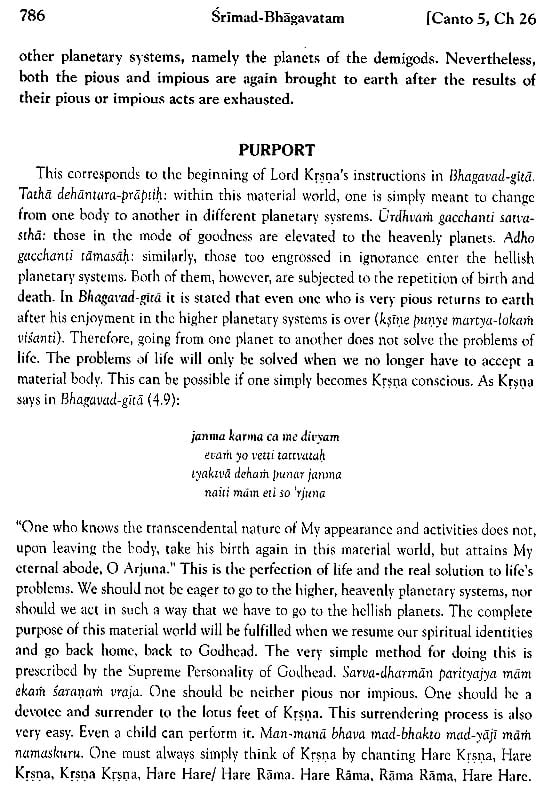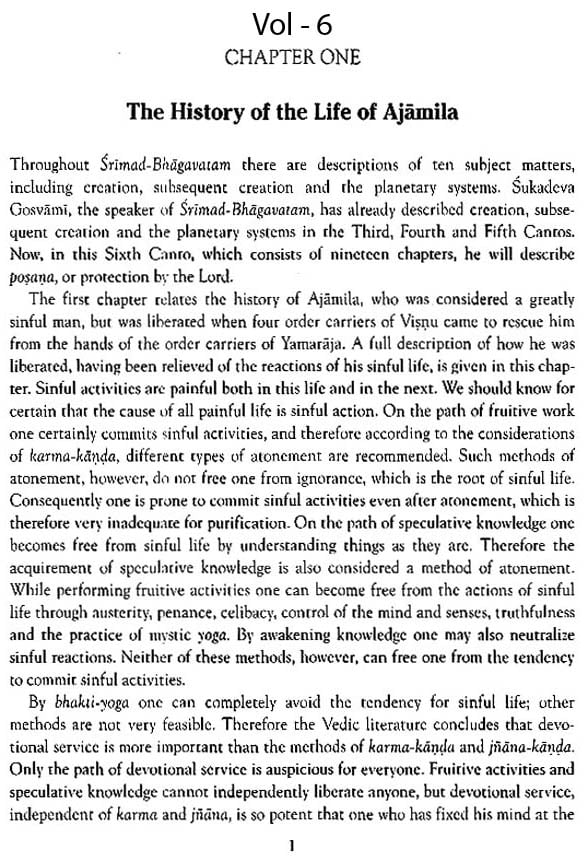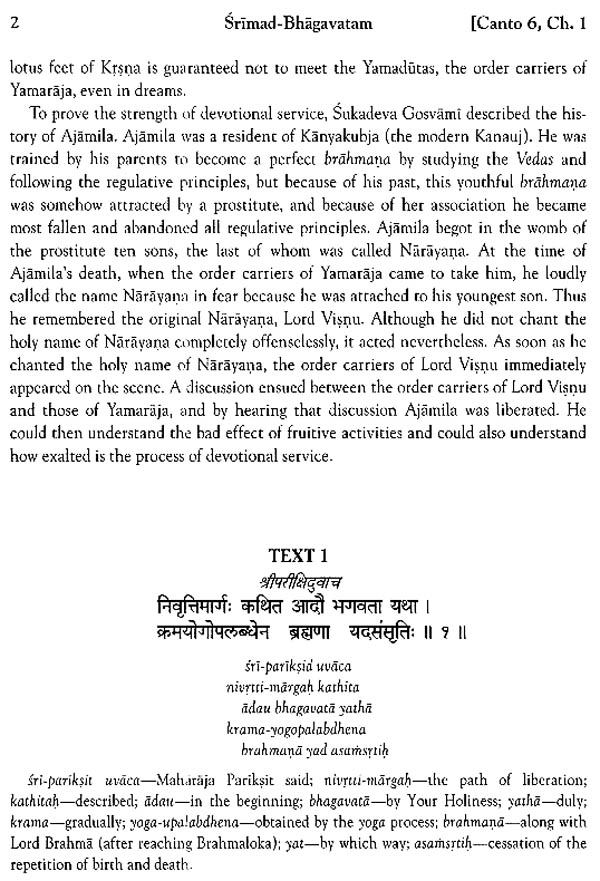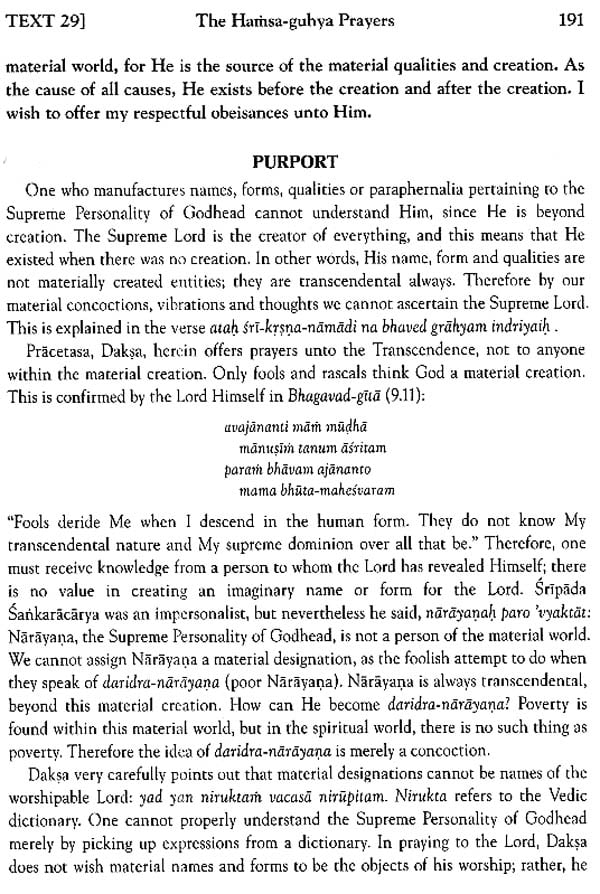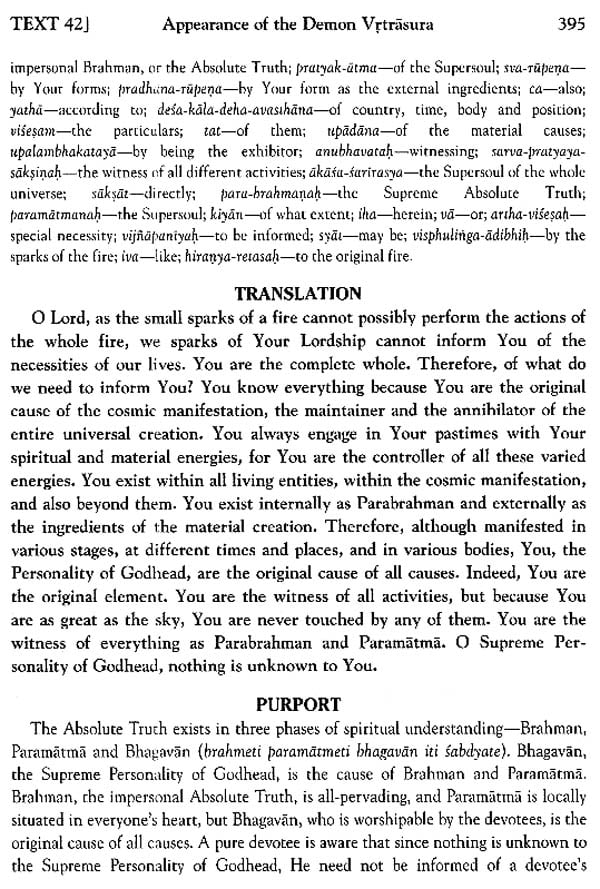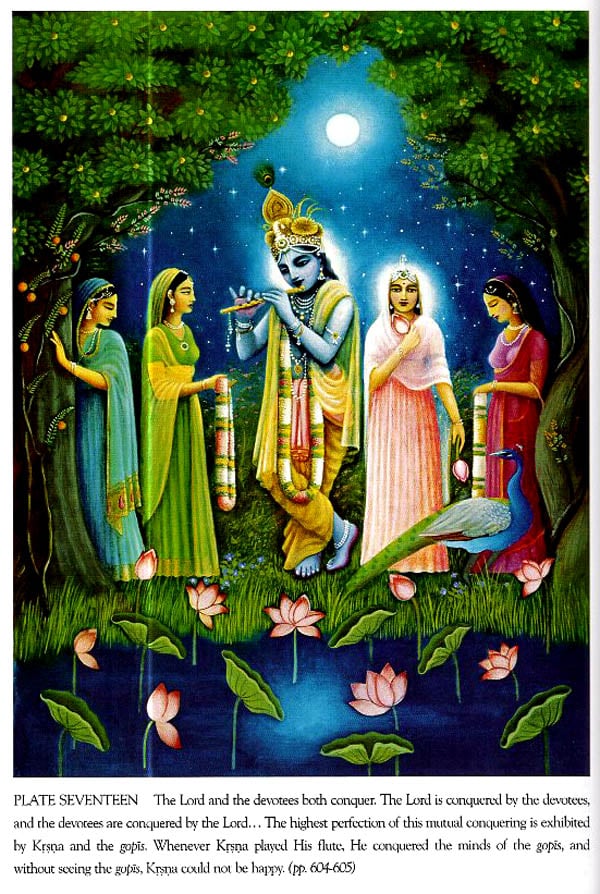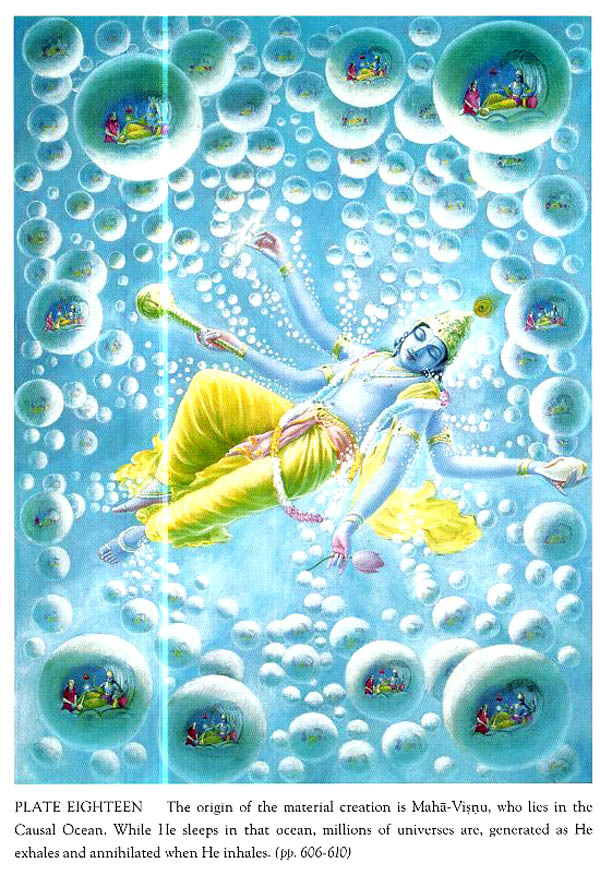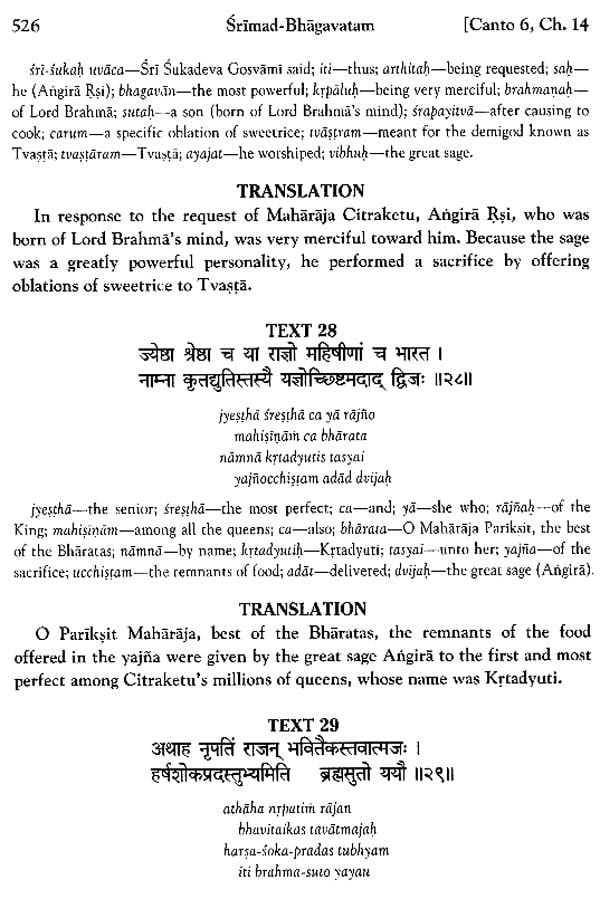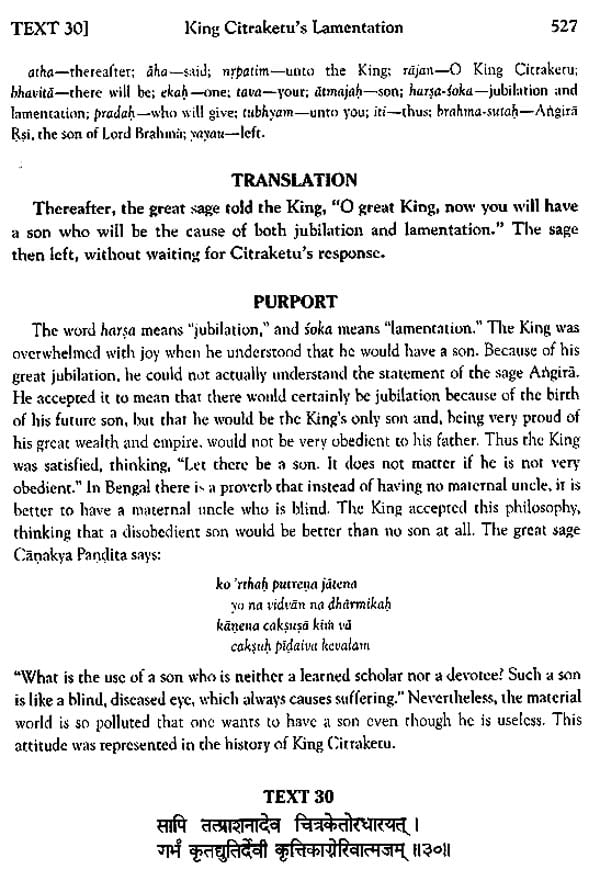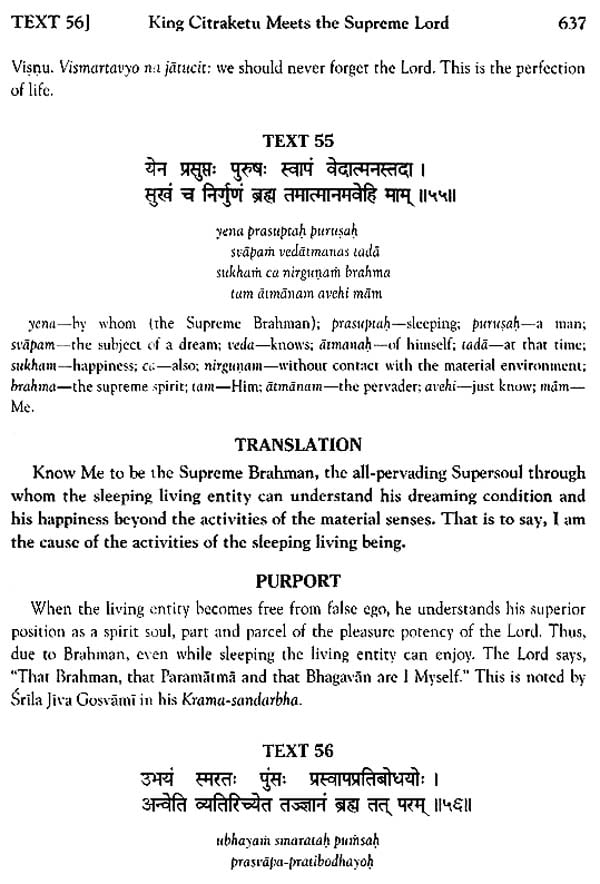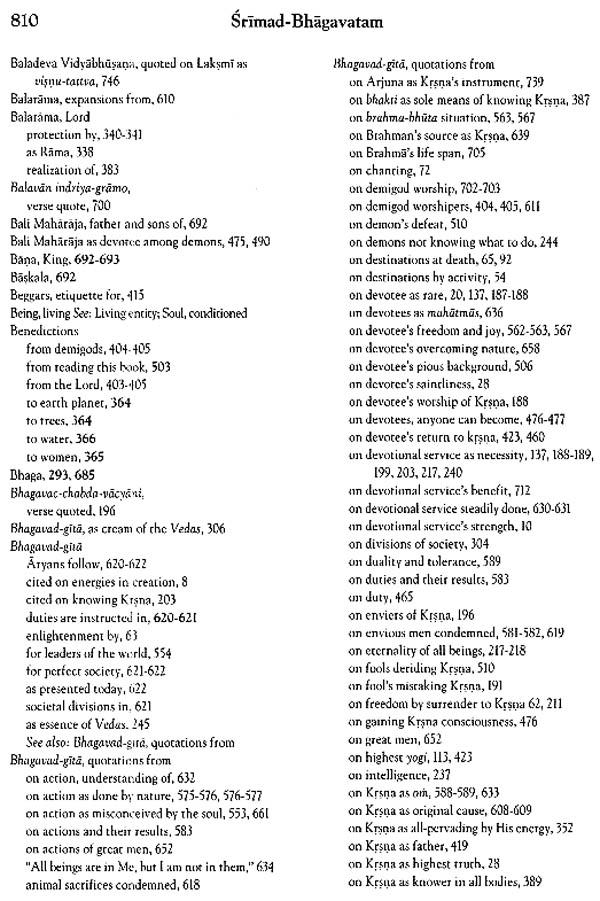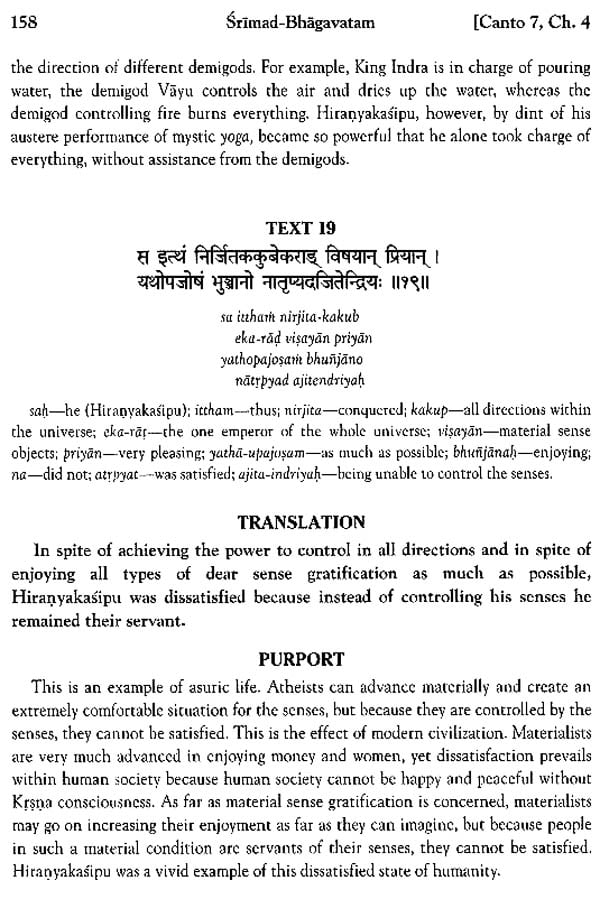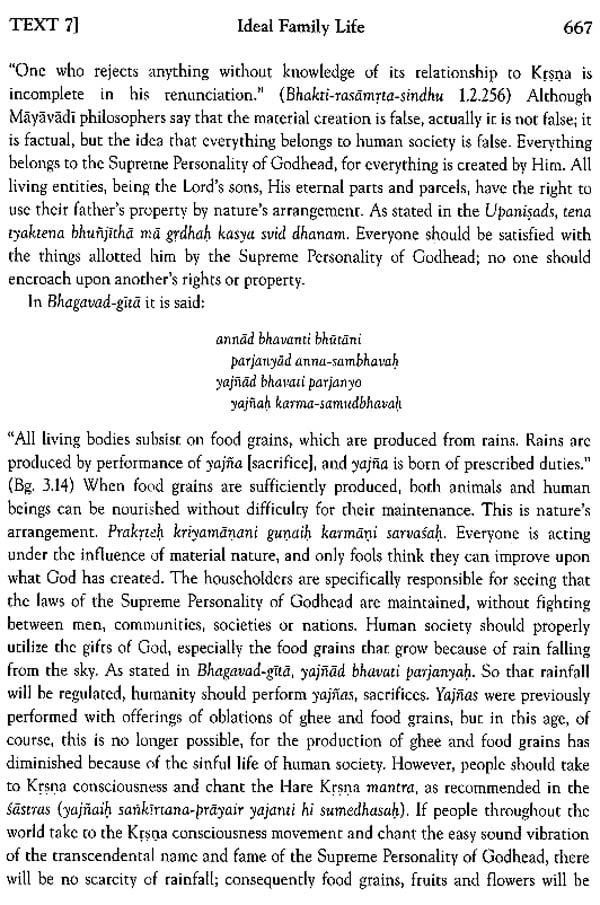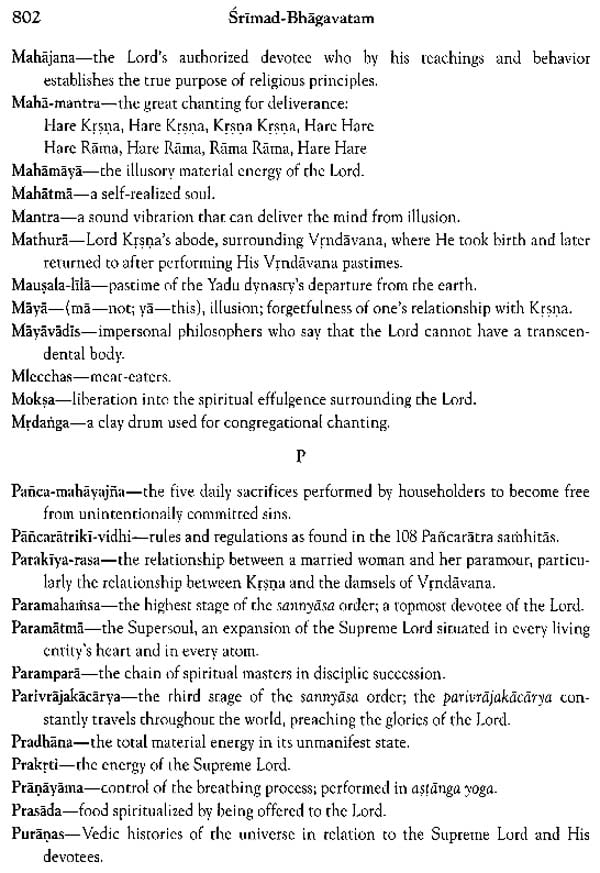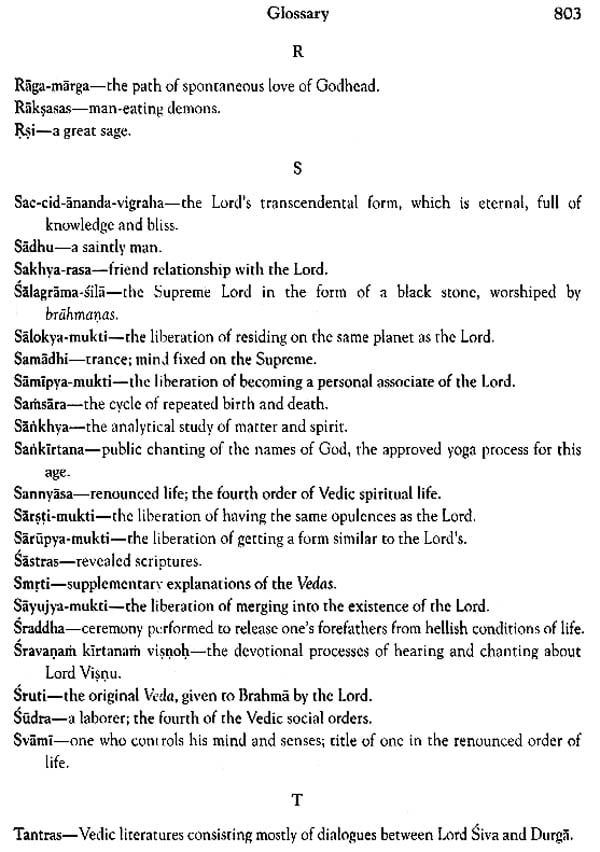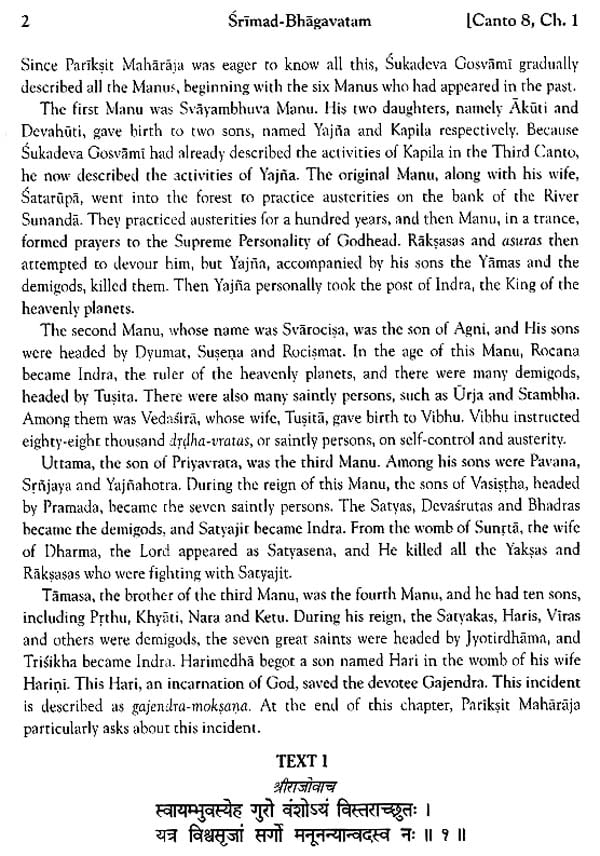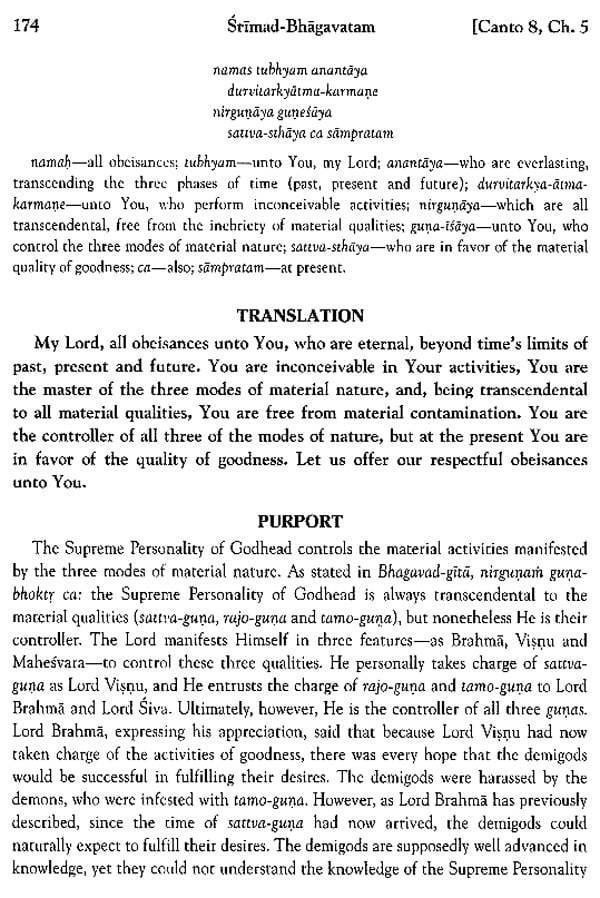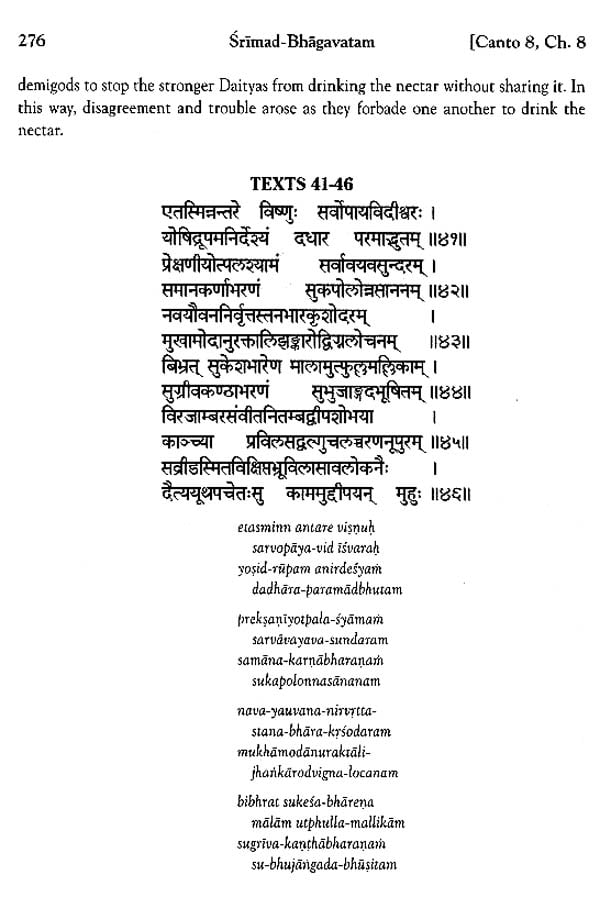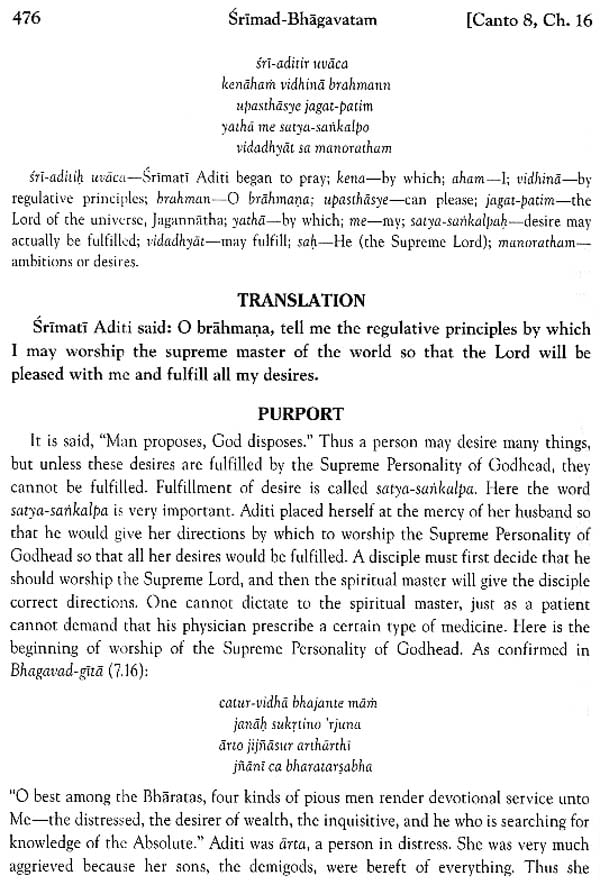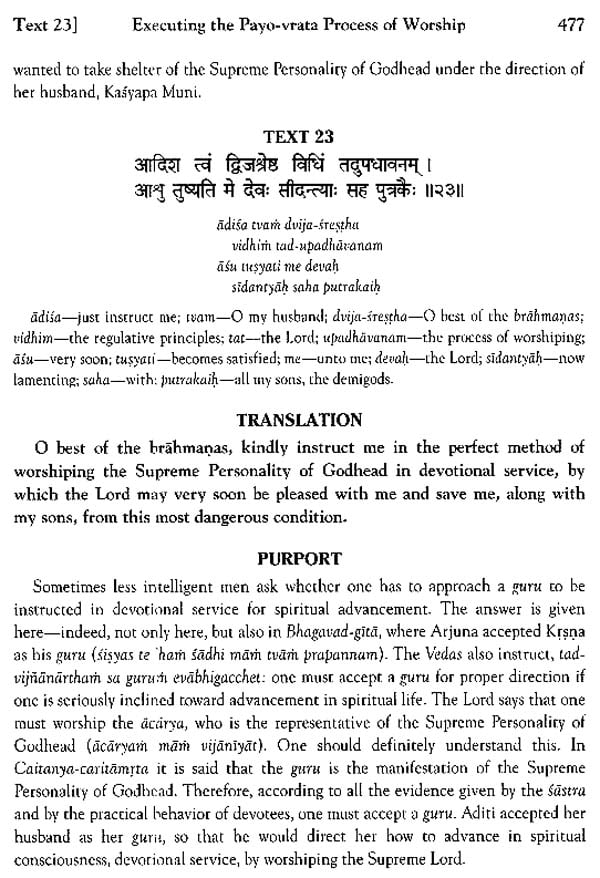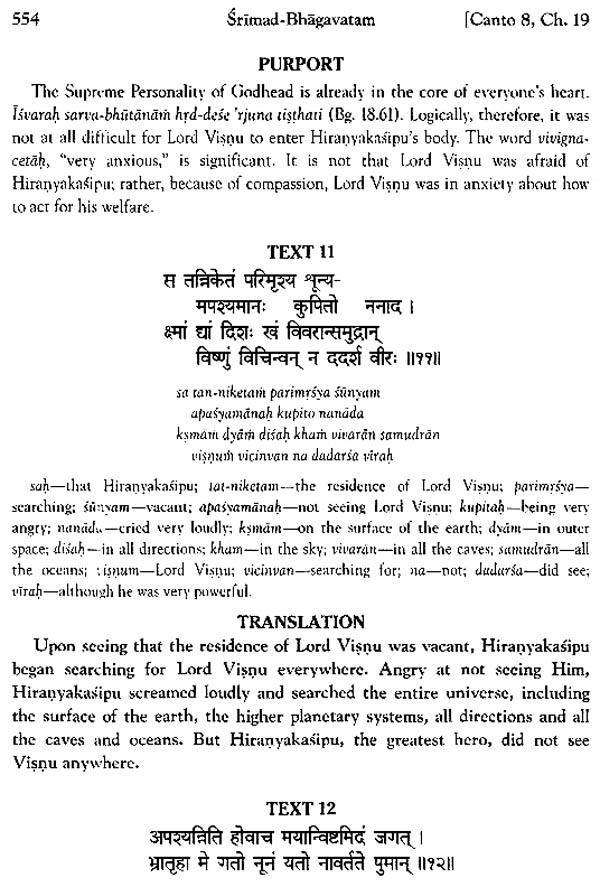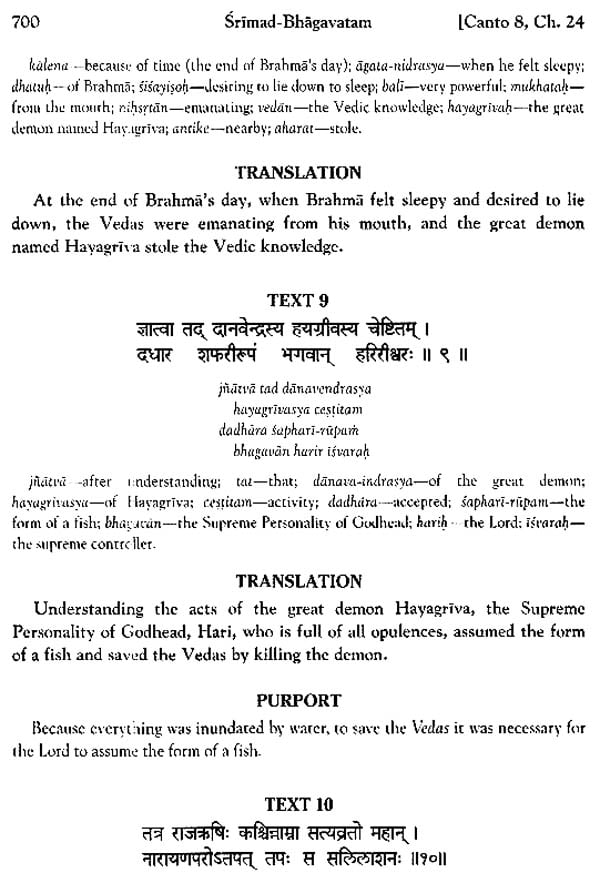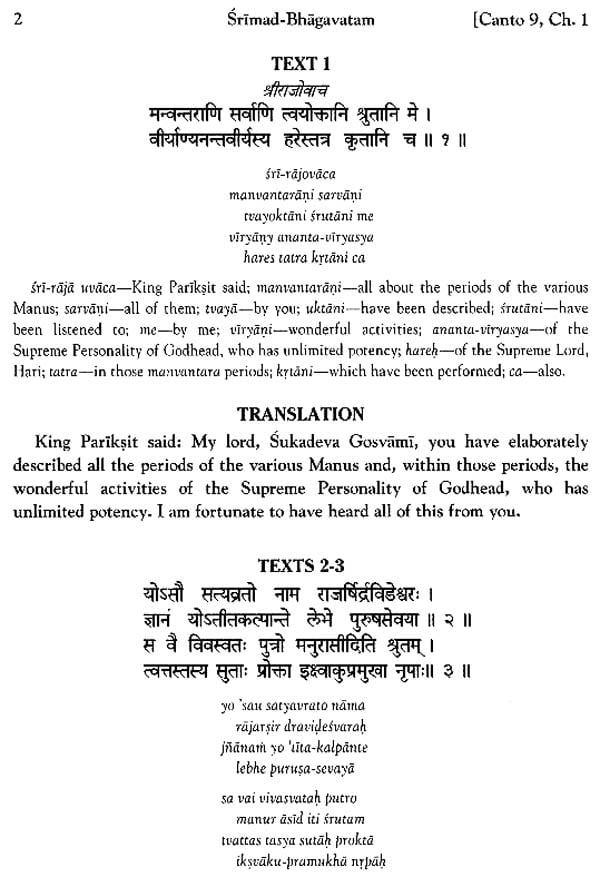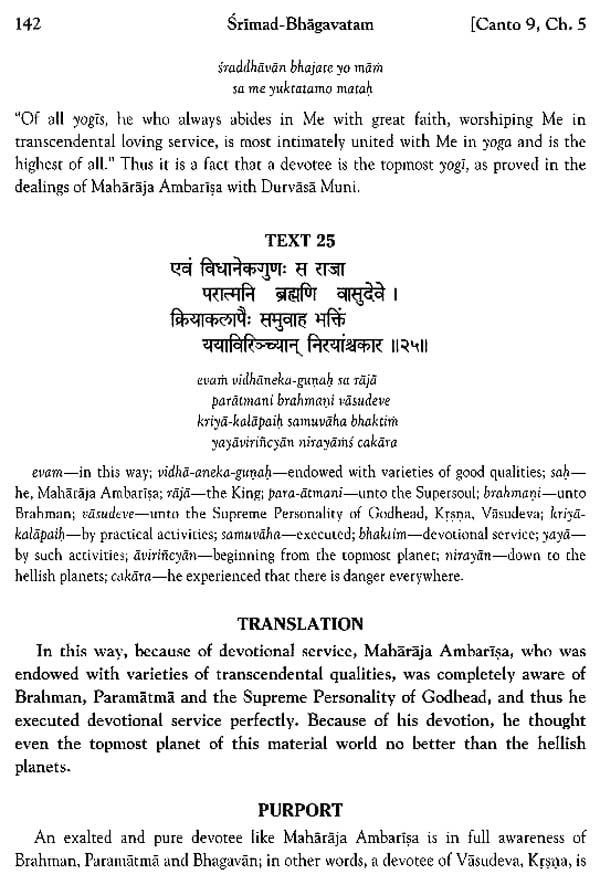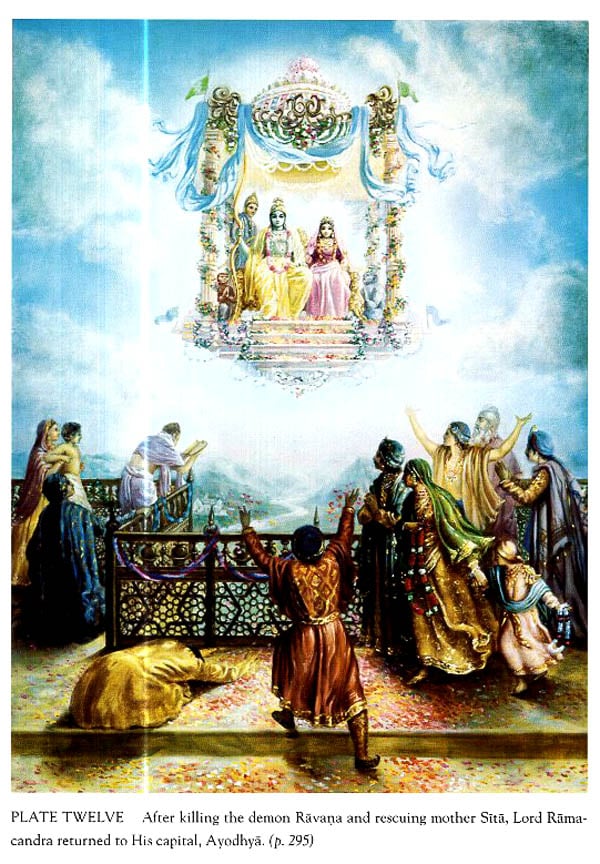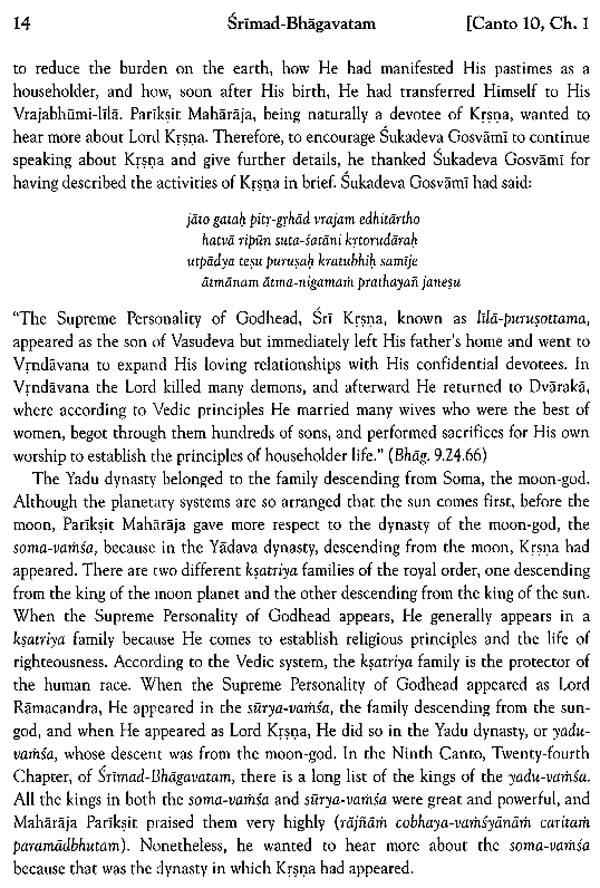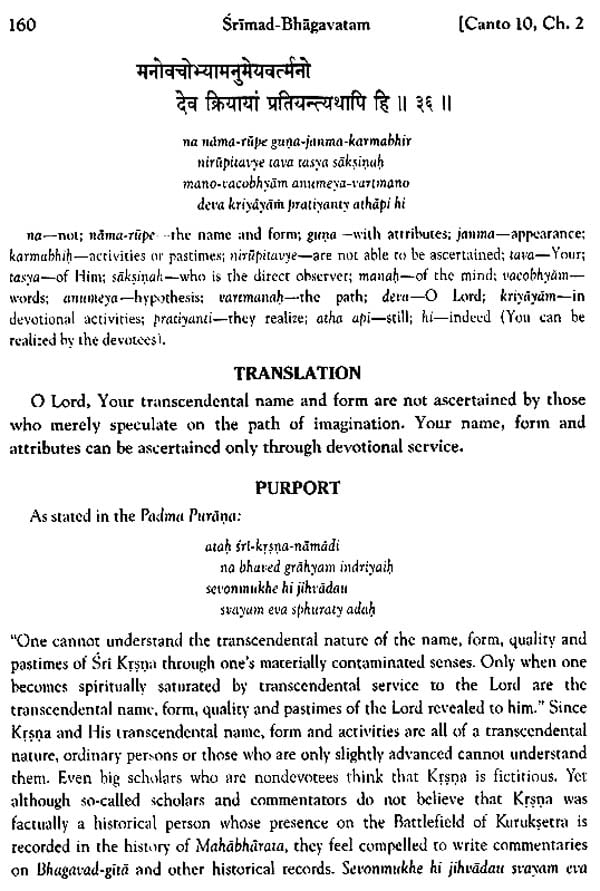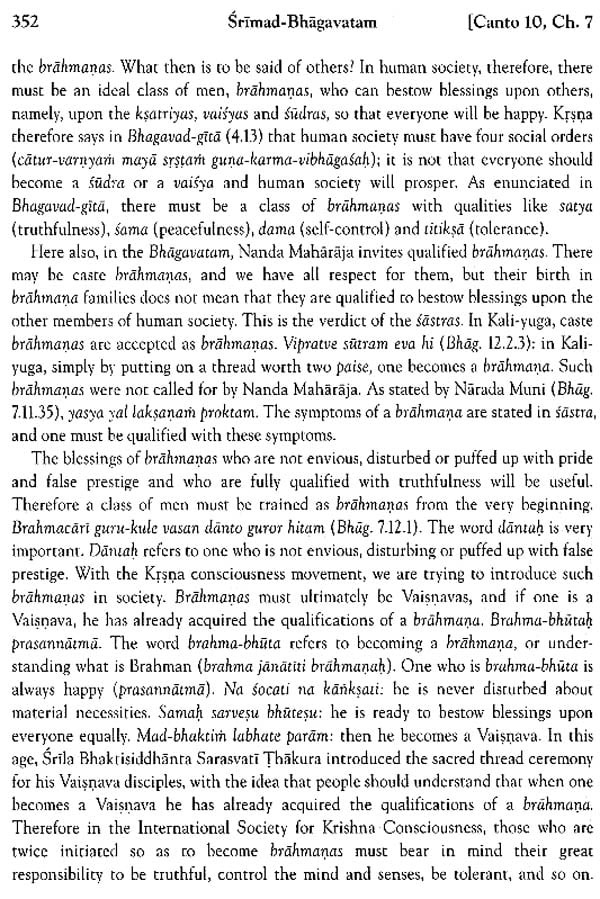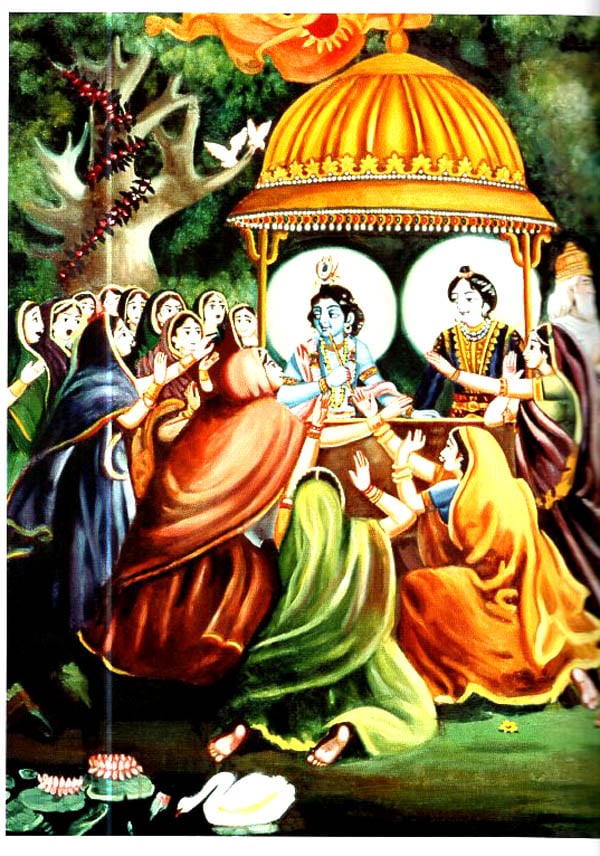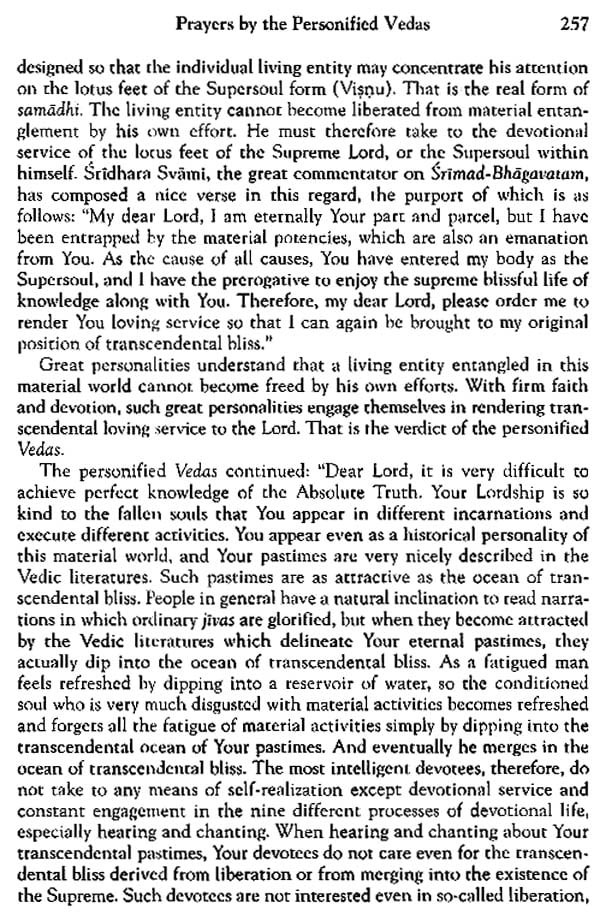
Srimad Bhagavatam: Sanskrit Text, Transliteration, Word-to-Word Meaning, English Translation and Detailed Explanation (Set of 10 Volumes Based on the First Edition)
Book Specification
| Item Code: | NAU562 |
| Author: | A.C. Bhaktivedanta Swami Prabhupada |
| Publisher: | Touch Stone Media |
| Language: | Sanskrit Text With English Translation |
| Edition: | 2016 |
| ISBN: | 9781602933002 |
| Pages: | 11,135 (479 Colored Illustrations) |
| Cover: | HARDCOVER |
| Other Details | 9.50 X 7.00 inch |
| Weight | 10.13 kg |
Book Description
His Divine Grace A. C. Bhaktivedanta Swami Prabhupada appeared in this world in 1896 in Calcutta, India. He first met his spiritual master, Srila Bhaktisiddhanta Sarasvati Gosvami, in Calcutta in 1922. Bhaktisiddhanta Sarasvati, a prominent religious scholar and the founder of sixty-four Gaudiya Mathas (Vedic institutes), liked this educated young man and convinced him to dedicate his life to teaching Vedic knowledge. Srila Prabhupada became his student, and eleven years later (1933) at Allahabad he became his formally initiated disciple.
At their first meeting, in 1922, Srila Bhaktisiddhanta Sarasvati Thakura requested Srila Prabhupada to broadcast Vedic knowledge through the English language. In the years that followed, Srila Prabhupada wrote a commentary on the Bhagavad-gita, assisted the Gaudiya Matha in its work and, in 1944, without assistance, started an English fortnightly magazine, edited it, typed the manuscripts and checked the galley proofs. He even distributed the individual copies freely and struggled to maintain the publication. Once begun, the magazine never stopped; it is now being continued by his disciples in the West.
Recognizing Srila Prabhupada’s philosophical learning and devotion, the Gaudiya Vaisnava Society honored him in 1947 with the title "Bhaktivedanta." In 1950, at the age of fifty-four, Srila Prabhupada retired from married life, and four years later he adopted the vanaprastha (retired) order to devote more time to his studies and writing. Srila Prabhupada traveled to the holy city of Vrndavana, where he lived in very humble circumstances in the historic medieval temple of Radha-Damodara. There he engaged for several vears in deep study and writing. He accepted the renounced order of life (sannyasa) in 1959. At Radha-Damodara, Srila Prabhupada began work on his life’s masterpiece: a multivolume translation and commentary on the eighteen thousand verse Srimad-Bhagavatam (Bhagavata Purana). He also wrote Easy Journey to Other Planets.
After publishing three volumes of the Bhdgavatam, Srila Prabhupada came to the United States, in 1965, to fulfill the mission of his spiritual master. Since that time, His Divine Grace has written over forty volumes of authoritative translations, commentaries and summary studies of the philosophical and religious classics of India.
In 1965, when he first arrived by freighter in New York City, Srila Prabhupada was practically penniless. It was after almost a year of great difficulty that he establish the International Society for Krishna Consciousness in July of 1966. Under his careful guidance, the Society has grown within a decade to a worldwide confederation of almost one hundred Gsramas, schools, temples, institutes and farm communities.
In 1968, Srila Prabhupada created New Vrndavana, an experimental Vedic community in the hills of West Virginia. Inspired by the success of New Vrndavana, now a thriving farm community of more than one thousand acres, his students have since founded several similar communities in the United States and abroad.
In 1972, His Divine Grace introduced the Vedic system of primary and secondary education in the West by founding the Gurukula school in Dallas, Texas. The school began with 3 children in 1972, and by the beginning of 1975 the enrollment had grown 150.
Srila Prabhupada also inspired the construction of a large international center at Sridhama Mayapur in West Bengal, India, which is also the site for a planned institute of Vedic Studies. A similar project is the magnificent Krsna-Balarama Temple and International Guest House in Vrndavana, India. These are centers where Westerners can live to gain firsthand experience of Vedic culture.
Srila Prabhupada’s most significant contribution, however, is his books. Highly respected by the academic community for their authoritiveness, depth and clarity, they are used as standard textbooks in numerous college courses. His writings have been translated into eleven languages. The Bhaktivedanta Book Trust, established in 1972 exclusively to publish the works of His Divine Grace, has thus become the world’s largest publisher of books in the field of Indian religion and philosophy. Its latest project is the publishing of Srila Prabhupada’s most recent work: a seventeen-volume translation and commentary—completed by Srila Prabhupada in only eighteen months—on the Bengali religious classic Sri Caitanya-caritamrta.
In the past ten years, in spite of his advanced age, Srila Prabhupada has circled the globe twelve times on lecture tours that have taken him to six continents. In spite of such a vigorous schedule, Srila Prabhupada continues to write prolifically. His writings constitute a veritable library of Vedic philosophy, religion, literature and culture.
We must know the present need of human society. And what is that need? Human society is no longer bounded by geographical limits to particular countries or communities. Human society-is broader than in the Middle Ages, and the world tendency is toward one state or one human society. The ideals of spiritual communism, according to Srimad-Bhagavatam, are based more or less on the oneness of the entire human society, nay, of the entire energy of living beings. The need is felt by great thinkers to make this a successful ideology. Srimad-Bhagavatam will fill this need in human society. It begins, therefore, with the aphorism of Vedanta philosophy (janmady asya yatah) to establish the ideal of a common cause.
Human society, at the present moment, is not in the darkness of oblivion. It has made rapid progress in the field of material comforts, education and economic development throughout the entire world. But there is a pinprick somewhere in the social body at large, and therefore there are large-scale quarrels, even over less important issues. There is need of a clue as to how humanity can become one in peace, friendship and prosperity with a common cause. Srimad-Bhagavatam will fill this need, for it is a cultural presentation for the respiritualization of the entire human society.
Srimad-Bhagavatam should be introduced also in the schools and colleges, for it is recommended by the great student-devotee Prahlada Maharaja in order to change the demoniac face of society.
Disparity in human society is due to lack of principles in a godless civilization. There is God, or the Almighty One, from whom everything emanates, by whom everything is maintained and in whom everything is merged to rest. Material science has tried to find the ultimate source of creation very insufficiently, but it is a fact that there is one ultimate source of everything that be. This ultimate source is explained rationally and authoritatively in the beautiful Bhagavatam or Srimad- Bhagavatam.
Stimad-Bhagavatam is the transcendental science not only for knowing the ultimate source of everything but also for knowing our relation with Him and our duty coward perfection of the human society on the basis of this perfect knowledge. It is powerful reading matter in the Sanskrit language, and it is now rendered into English elaborately so that simply by a careful reading one will know God perfectly well, so much so thar che reader will be sufficiently educated to defend himself from the on- slaught of atheists. Over and above this, the reader will be able to convert others to accepting God as a concrete principle.
Stimad-Bhagavatam begins with the definition of the ultimate source. It is a bonafide commentary on the Vedanta-sitera by the same author, Srila Vyasadeva, andgradually it develops into nine cantos up to the highest state of God realization. The only qualification one needs to study this great book of transcendental knowledge is to proceed step by step cautiously and not jump forward haphazardly like with an ordinary book. It should be gone through chapter by chapter, one after another. The reading matter is so arranged with its original Sanskrit text, its English transliteration, synonyms, translation and purports so that one is sure to become a God-realized soul at the end of finishing the first nine cantos.
The Tenth Canto is distinct from the first nine cantos because it deals directly with the transcendental activities of the Personality of Godhead Sti Krsna.One will be unable co capture the effects of the Tenth Canto without going through the first nine cantos. The book is complete in twelve cantos, each independent, bur it is good for all to read them in small installments one after another.
I must admit my frailties in presenting Srimad-Bhagavatam, but still Lam hopeful of its good reception by the thinkers and leaders of society on the strength of the following statement of Srimad-Bhagavatam
"On the other hand, that literature which is full with descriptions of the transcen- dental glories of the name, fame, form and pastimes of the unlimited Supreme Lord is a transcendental creation meant to bring about a revolution in the impious life of a misdirected civilization. Such transcendental literatures, even though irregularly com- posed, are heard, sung and accepted by purified men who are thoroughly honest."
"This Bhagavata Purana is as brilliant as the sun, and it has arisen just after the departure of Lord Krsna to His own abade, accompanied by religion, knowledge, etc. Persons who have lost their vision due to the dense darkness of ignorance in the age of Kali shall get light from this Purana." (Srimad-Bhagavatam 13.43)
The timeless wisdom of India is expressed in the Vedas, ancient Sanskrit texts char touch upon all fields of human knowledge. Originally preserved through oral tradition, the Vedas were first put into writing five thousand years ago by Srila Vyasadeva, che "literary incarnation of God." After compiling the Vedas, Vyisadeva set forth their essence in the aphorisms known as Vedanta-sittras. Srimad-Bhdgavatam (Bhagavata Purana) is Vyasadeva’s commentary on his own Vedanta-sitras. It was written in the maturity of his spiritual life under the direction of Narada Muni, his spiritual master. Referred to as "the ripened fruit of the tree of Vedic literature," Srimad-Bhagavatam is the most complete and authoritative exposition of Vedic knowledge.
After compiling the Bhagavatam, Vyasa imparted the synopsis of it to his son, the sage Sukadeva Goswami. Sukadeva Gosvami subsequently recited the entire Bhagavatam to Maharaja Pariksit in an assembly of learned saints on the bank of the Ganges at Hastinapura (now Delhi). Maharaja Pariksit was the emperor of the world and was a great rdjarsi (saintly king). Having received a warning that he would die within a week, he renounced his entire kingdom and retired to the bank of the Ganges to fast until death and receive spiritual enlightenment. The Bhagavacam begins with Emperor Pariksit's sober inquiry to Sukadeva Gosvami:
"You are the spiritual master of great saints and devotees. Tam therefore begging you to show the way of perfection for all persons, and especially for one who is about to die. Please let me know what a man should hear, chant, remember and worship, and also what he should not do. Please explain all this to me."
Sukadeva Gosvami's answer to this question, and numerous other questions posed by Maharaja Pariksit, concerning everything from the nature of the self to the origin of the universe, held the assembled sages in rapt attention continuously for the seven days leading up to the king's death. The sage Sita Gosvami, who was present in that assembly when Sukadeva Gosvami first recited Srimad-Bhagavatam, later repeated the Bhdgavatam before a yathering of sages in the forest of Naimisdranya. Those sages, concerned about the spiritual welfare of the people in general, had gathered to perform a long, continuous chain of sacrifices to counteract the degrading influence of the incipient age of Kali. In response to the sages’ request thar he speak the essence of Vedic wisdom, Sita Gosvami repeated from memory the entire eighteen thousand verses of Srimad-Bhagavatam, as spoken by Sukadeva Gasvami to Maharaja Pariksie.
The reader of Srimad-Bhagavatam hears Sita Gosvami relate the questions of Maharaja Pariksit and the answers of Sukadeva Gosvami. Also, Sita Gosvami sometimes responds directly to the questions put by Saunaka Rsi, the spokesman for the sages gathered at Naimisaranya. One therefore simultaneously hears two dialogues: one between Maharaja Pariksit and Sukadeva Gosvami on the bank of the Ganges, and another at Naimisaranya between Sita Gosvami and the sages at Naimisaranya forest, headed by Saunaka Rsi. Furthermore, while instructing King Pariksit, Sukadeva Gosvami often relates historical episodes and gives accounts of lengthy philosophical discussions between such great souls as the saint Maitreya and his disciple Vidura. Wich this understanding of the history of the Bhdgavatam, the reader will easily be able to follow its intermingling of dialogues and events from various sources. Since philosophical wisdom, not chronological order, is most important in the text, one need only be attentive to the subject matter of Srimad-Bhagavatam to appreciate fully its profound message.
The translator of this edition compares the Bhdgavaram to sugar candy— wherever you taste it, you will find it equally sweet and relishable. Therefore, to taste the sweetness of the Bhdgavatam, one may begin by reading any of its volumes. After such an introductory taste, however, the serious reader is best advised to go back to-the First Canto and then proceed through the Bhagavatam, canto after canto, in its natural order.
This edition of the Bhagavatam is the first complete English translation of this important text with an elaborate commentary, and it is the first widely available to the English-speaking public. The first twelve volumes (Canto One through Canto Ten, Part One) are the product of the scholarly and devotional effort of His Divine Grace A-C.Bhaktivedanta Swami Prabhupada, the founder-dedrya of the International Society for Krishna Consciousness and the world’s most distinguished ceacher of Indian religious and philosophical thought. His consummate Sanskrit scholarship and intimate familiarity with Vedic culture and thought as well as the modern way of life combine to reveal to the West a magnificent exposition of this important classic.
Readers will find this work of value for many reasons. For those interested in the classical roots of Indian civilization, it serves as a vast reservoir of detailed infor- mation on virtually every one of its aspects. For students of comparative philosophy and religion, the Bhagavatam offers a penetrating view into the meaning of India’s profound spiritual heritage. To sociologists and anthropologists, the Bhagavatam reveals the practical workings of a peaceful and scientifically organized Vedic culture, whose institutions were integrated on the basis of a highly developed spiritual world view.
Students of literature will discover the Bhdgawatam to be a master piece of majestic poetry. For students of psychology, the text provides important perspectives on the nature of consciousness, human behavior and the philosophical study of identity. Finally, to those secking spiritual insight, the Bhagavatam offers simple and practical guidance for attainment of the highest self-knowledge and realization of the Absolute Truth. The entire multivolume text, presented by the Bhaktivedanta Book Trust, promises to occupy a significant place in the intellectual, cultural and spiritual life of modern man for a long time to come.
The conception of God and the conception of Absolute Truth are not on the same level. The Srimad-Bhagavatam hits on the target of che Absolute Truth. The conception of God indicates the controller, whereas the conception of the Absolute Truth indicates the semmum boniwn or che ultimate source of all energies. There is no difference of opinion about the personal feature of God as the controller because a controller cannot be impersonal. Of course modern government, especially democratic government, is impersonal to some extent, but ultimately the chief executive head is a person, and the impersonal feature of government is subordinate to the personal feature. So without a doubt whenever we refer to control over others we must admit the existence of a personal feature. Because there are different controllers for different managerial positions, there may be many small gods. According to the Bhagavad-gita any controller who has some specific extraordinary power is called a vibhutimar sattva, or controller empowered by the Lord. There are many vibhutimat sattvas, controllers or gods with various specific powers, but the Absolute Truth is one without a second. This Srimad-Bhagavatam designates the Absolute Truth or the summum bonum as the param satyam.
The author of Stimad-Bhagavatam, Srila Vyasadeva, first affers his respectful obeisances unto the pararh satyam (Absolute Truth), and because the pararh satyam is the ultimate source of all energies, the parati satyam is the Supreme Person. The gods or the controllers are undoubtedly persons, but the param satyam from whom the gods derive powers of control is the Supreme Person. The Sanskrit word isvara (controller) conveys the import of God, bur che Supreme Person is called the paramesvara, or the supreme fsvara. The Supreme Person, or paramesvara, is the supreme conscious personality, and because He does not derive any power from any other source, He is supremely independent. In the Vedic literatures Brahma is described as the supreme god or the head of all other gods fike Indra, Candta and Varuna, but the Stimad- Bhagavatam confirms that even Brahma is not independent as far as his power and knowledge are concerned. He received knowledge in the form of the Vedas from the Supreme Person who resides within the heart of every living being. That Supreme Personality knows everything directly and indirectly. Individual infiniresimal persons, who are parts and parcels of the Supreme Personality, may know directly and indirectly everything about their bodies or external features, but the Supreme Personality knows everything about both His external and internal features.
The words janmdady asya suggest that the source of all production, maintenance or destruction is the same supreme conscious person. Even in our present experience we can know that nothing is generated from inert matter, but inert macter can be generated from che living entity. For instance, by contact with the living entiry, the material body develops into a working machine. Men with a poor fund of knowledge mistake the bodily machinery to be the living being, but the fact is that the living being is the basis of the bodily machine. The bodily machine is useless as soon as the living spark is away from it. Similarly, the original source of all material energy is the Supreme Person. This fact is expressed in all the Vedic literatures, and all the exponents of spiritual science have accepted this truth. The living force is called Brahman, and one of the greatest dcdryas (teachers), namely Sripida Sankaracarya, has preached that Brahman is substance whereas che cosmic world is category. The original source of all energies is the living force, and He is logically accepted as the Supreme Person. He is therefore conscious of everything past, present and future, and also of each and every corner of His manifestations, both material and spiritual. An imperfect living being does not even know what is happening within his own personal body. He eats his food but does not know how this food is transformed into energy or how it sustains his body. When a living being is perfect, he is aware of everything that happens, and since the Supreme Person is all-perfecr, it is quite natural that He knows everything in all detail. Consequently the perfect personality is addressed in the Srimad-Bhagavatam as Vasudeva, or one who lives everywhere in full consciousness and in full possession of His complete energy. All of this is clearly explained in the Srimad-Bhagavatam, and the reader has ample opportunity co study this critically.
In the modern age Lord Sti Caitanya Mahaprabhu preached the Srimad-Bhagavatam by practical demonstration. It is easier to penetrate into the topics of the Srimad-Bhagavatam through the medium of Sri Caitanya’s causeless mercy. Therefore a short sketch of His life and precepts is inserted herein to help the reader understand the real merit of Svimad-Bhagavatam.
It is imperative chat one learn the Srimad-Bhdgavatam from the person Bhagavaram. The person Bhagavatam is one whose very life is Srimad-Bhagavatam in practice. Since Sri Chaitanya Mahaprabhu is the Absolute Personality of Godhead, He is both Bhagavan and Bhdgavatam in person and in sound. Therefore His process of approaching the Srimad-Bhagavatam is practical for all people of the world. It was His wish that the Srimad-Bhagavatam be preached in every nook and corner of the world by those who happened to take their birth in India.
The Srimad-Bhdgavatam is the science of Krsna, the Absolute Personality of Godhead of whom we have preliminary information from the text of the Bhagavad-gitd. Sti Caitanya Mahaprabhu has said that anyone, regardless of what he is, who is well versed in the science of Krsna (Srimad-Bhdgavatam and Bhagavad-gita) can become an authorized preacher or preceptor in the science of Krsna.
There is a need for the science of Krsna in human society for the good of all suffer- ing humanity of the world, and we simply request the leaders of all nations to pick up this science of Krsna for their own good, for the good of society and for the good of all the world’s people.
**Contents and Sample Pages**
